ABSTRACT ATTITUDE TRACKING CONTROL FOR SPACECRAFT FORMATION FLYING
- 格式:pdf
- 大小:233.52 KB
- 文档页数:13
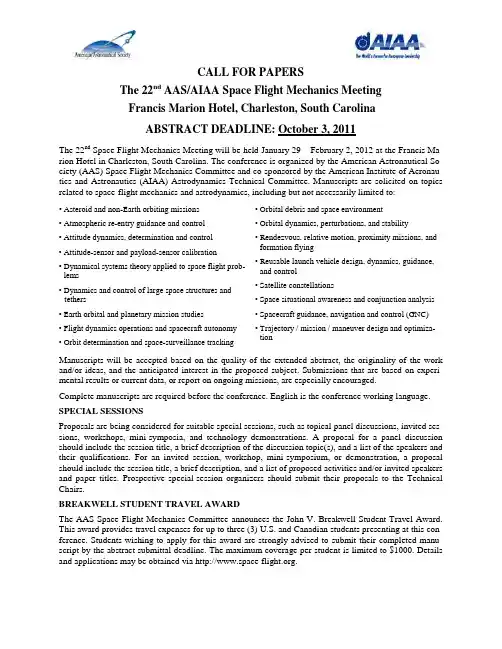
CALL FOR PAPERSThe 22nd AAS/AIAA Space Flight Mechanics MeetingFrancis Marion Hotel, Charleston, South CarolinaABSTRACT DEADLINE:The 22nd Space Flight Mechanics Meeting will be held January 29 – February 2, 2012 at the Francis Ma-rion Hotel in Charleston, South Carolina. The conference is organized by the American Astronautical So-ciety (AAS) Space Flight Mechanics Committee and co-sponsored by the American Institute of Aeronau-tics and Astronautics (AIAA) Astrodynamics Technical Committee. Manuscripts are solicited on topics related to space-flight mechanics and astrodynamics, including but not necessarily limited to:October 3, 2011• Asteroid and non-Earth orbiting missions• Atmospheric re-entry guidance and control• Attitude dynamics, determination and control• Attitude-sensor and payload-sensor calibration• Dynamical systems theory applied to space flight prob-lems• Dynamics and control of large space structures and tethers• Earth orbital and planetary mission studies• Flight dynamics operations and spacecraft autonomy • Orbit determination and space-surveillance tracking • Orbital debris and space environment• Orbital dynamics, perturbations, and stability• Rendezvous, relative motion, proximity missions, and formation flying• Reusable launch vehicle design, dynamics, guidance, and control• Satellite constellations• Space situational awareness and conjunction analysis • Spacecraft guidance, navigation and control (GNC) • Trajectory / mission / maneuver design and optimiza-tionManuscripts will be accepted based on the quality of the extended abstract, the originality of the work and/or ideas, and the anticipated interest in the proposed subject. Submissions that are based on experi-mental results or current data, or report on ongoing missions, are especially encouraged.Complete manuscripts are required before the conference. English is the conference working language. SPECIAL SESSIONSProposals are being considered for suitable special sessions, such as topical panel discussions, invited ses-sions, workshops, mini-symposia, and technology demonstrations. A proposal for a panel discussion should include the session title, a brief description of the discussion topic(s), and a list of the speakers and their qualifications. For an invited session, workshop, mini-symposium, or demonstration, a proposal should include the session title, a brief description, and a list of proposed activities and/or invited speakers and paper titles. Prospective special-session organizers should submit their proposals to the Technical Chairs.BREAKWELL STUDENT TRAVEL AWARDThe AAS Space Flight Mechanics Committee announces the John V. Breakwell Student Travel Award. This award provides travel expenses for up to three (3) U.S. and Canadian students presenting at this con-ference. Students wishing to apply for this award are strongly advised to submit their completed manu-script by the abstract submittal deadline. The maximum coverage per student is limited to $1000. Details and applications may be obtained via .INFORMATION FOR AUTHORSBecause the submission deadline of October 3, 2011 has been fully extended for the convenience of con-tributors, there are no plans to defer this deadline due to the constraints of the conference planning sche-dule. Notification of acceptance will be sent via email by November 14, 2011. Detailed author instruc-tions will be sent by email following acceptance. By submitting an abstract, the author affirms that the manuscript’s majority content has not been previously presented or published elsewhere.Authors may access the web-based abstract submittal system using the link available via the official web-site . During the online submission process, authors are expected to provide: 1. a paper title, as well as the name, affiliation, postal address, telephone number, and email address of thecorresponding author and each co-author,2. an extended abstract in the Portable Document File (PDF) format of at least 500 words that includes thetitle and authors, and provides a clear and concise statement of the problem to be addressed, the pro-posed method of solution, the results expected or obtained, and an explanation of its significance to as-trodynamics and/or space-flight mechanics, with pertinent references and supporting tables and figures as necessary, and,3. a condensed abstract (100 words) to be included in the conference program, which is directly typed intothe text box provided on the web page and avoids the use of special symbols or characters, such as Greek letters.Foreign contributors requiring an official letter of acceptance for a visa application should contact the Technical Chairmen by email at their earliest opportunity.Technology Transfer Notice - Technology transfer guidelines substantially extend the time required to review abstracts and manuscripts by private enterprises and government agencies. To preclude late sub-missions and withdrawals, it is the responsibility of the author(s) to determine the extent of necessary ap-provals prior to submitting an abstract.No-Paper/No-Podium Policy – A complete manuscript must be electronically uploaded to the web site prior to the conference in PDF format, be no more than twenty (20) pages in length, and conform to the AAS manuscript format. If a complete manuscript is not received on time, then its presentation at the con-ference shall be forfeited; and if a presentation is not made by an author at the conference, then the manu-script shall be omitted from published proceedings.Questions concerning the submission of manuscripts should be addressed to the technical chairs:AAS Technical ChairMr. James McAdamsJohns Hopkins University Applied Physics Laboratory 11100 Johns Hopkins RoadLaurel, MD 20723-6099(240) 228-8685 (voice)Jim.McAdams@ AIAA Technical ChairMr. David McKinleya.i. solutions, Inc.10001 Derekwood Lane, Suite 215 Lanham, MD 20706(410) 980-2904 (voice)david.mckinley@All other questions should be directed to the General Chairs:AAS General ChairDr. Matthew Berry Analytical Graphics, Inc. 220 Valley Creek Boulevard Exton, PA 19341(610) 981-8213 (voice) mberry@ AIAA General ChairMr. Keith L. Jenkins, Esq.Keith L. Jenkins., Registered Patent Attorney, LLC 44075 W. Neely DriveMaricopa, AZ 85138(480) 390-6179 (voice)keith@。
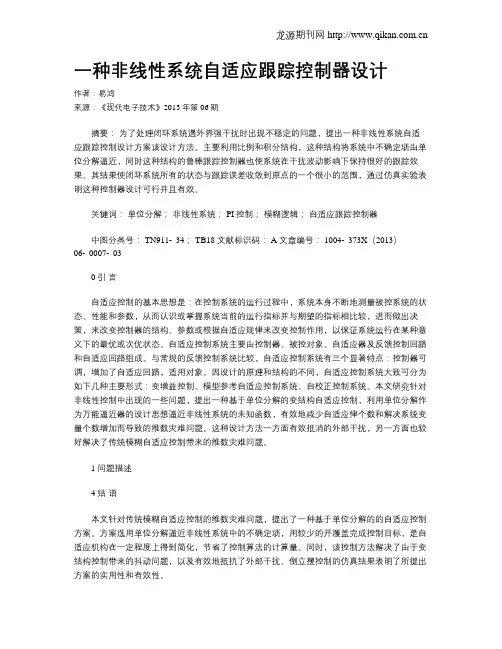
一种非线性系统自适应跟踪控制器设计作者:易鸿来源:《现代电子技术》2013年第06期摘要:为了处理闭环系统遇外界强干扰时出现不稳定的问题,提出一种非线性系统自适应跟踪控制设计方案该设计方法。
主要利用比例和积分结构,这种结构将系统中不确定项由单位分解逼近,同时这种结构的鲁棒跟踪控制器也使系统在干扰波动影响下保持很好的跟踪效果。
其结果使闭环系统所有的状态与跟踪误差收敛到原点的一个很小的范围,通过仿真实验表明这种控制器设计可行并且有效。
关键词:单位分解;非线性系统; PI控制;模糊逻辑;自适应跟踪控制器中图分类号: TN911⁃34; TB18 文献标识码: A 文章编号: 1004⁃373X(2013)06⁃0007⁃030 引言自适应控制的基本思想是:在控制系统的运行过程中,系统本身不断地测量被控系统的状态、性能和参数,从而认识或掌握系统当前的运行指标并与期望的指标相比较,进而做出决策,来改变控制器的结构、参数或根据自适应规律来改变控制作用,以保证系统运行在某种意义下的最优或次优状态。
自适应控制系统主要由控制器、被控对象、自适应器及反馈控制回路和自适应回路组成。
与常规的反馈控制系统比较,自适应控制系统有三个显著特点:控制器可调,增加了自适应回路,适用对象。
因设计的原理和结构的不同,自适应控制系统大致可分为如下几种主要形式:变增益控制、模型参考自适应控制系统、自校正控制系统。
本文研究针对非线性控制中出现的一些问题,提出一种基于单位分解的变结构自适应控制,利用单位分解作为万能逼近器的设计思想逼近非线性系统的未知函数,有效地减少自适应律个数和解决系统变量个数增加而导致的维数灾难问题。
这种设计方法一方面有效抵消的外部干扰,另一方面也较好解决了传统模糊自适应控制带来的维数灾难问题。
1 问题描述4 结语本文针对传统模糊自适应控制的维数灾难问题,提出了一种基于单位分解的的自适应控制方案。
方案选用单位分解逼近非线性系统中的不确定项,用较少的开覆盖完成控制目标,是自适应机构在一定程度上得到简化,节省了控制算法的计算量。
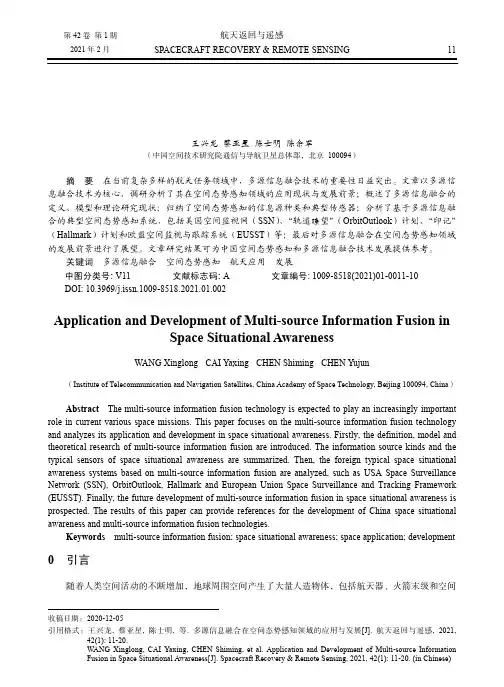
第42卷第1期航天返回与遥感2021年2月SPACECRAFT RECOVERY & REMOTE SENSING11多源信息融合在空间态势感知领域的应用与发展王兴龙 蔡亚星 陈士明 陈余军(中国空间技术研究院通信与导航卫星总体部,北京 100094)摘要在当前复杂多样的航天任务领域中,多源信息融合技术的重要性日益突出。
文章以多源信息融合技术为核心,调研分析了其在空间态势感知领域的应用现状与发展前景;概述了多源信息融合的定义、模型和理论研究现状;归纳了空间态势感知的信息源种类和典型传感器;分析了基于多源信息融合的典型空间态势感知系统,包括美国空间监视网(SSN)、“轨道瞭望”(OrbitOutlook)计划、“印记”(Hallmark)计划和欧盟空间监视与跟踪系统(EUSST)等;最后对多源信息融合在空间态势感知领域的发展前景进行了展望。
文章研究结果可为中国空间态势感知和多源信息融合技术发展提供参考。
关键词多源信息融合空间态势感知航天应用发展中图分类号: V11文献标志码: A 文章编号: 1009-8518(2021)01-0011-10DOI: 10.3969/j.issn.1009-8518.2021.01.002Application and Development of Multi-source Information Fusion inSpace Situational AwarenessWANG Xinglong CAI Yaxing CHEN Shiming CHEN Yujun(Institute of Telecommunication and Navigation Satellites, China Academy of Space Technology, Beijing 100094, China)Abstract The multi-source information fusion technology is expected to play an increasingly important role in current various space missions. This paper focuses on the multi-source information fusion technology and analyzes its application and development in space situational awareness. Firstly, the definition, model and theoretical research of multi-source information fusion are introduced. The information source kinds and the typical sensors of space situational awareness are summarized. Then, the foreign typical space situational awareness systems based on multi-source information fusion are analyzed, such as USA Space Surveillance Network (SSN), OrbitOutlook, Hallmark and European Union Space Surveillance and Tracking Framework (EUSST). Finally, the future development of multi-source information fusion in space situational awareness is prospected. The results of this paper can provide references for the development of China space situational awareness and multi-source information fusion technologies.Keywords multi-source information fusion; space situational awareness; space application; development 0 引言随着人类空间活动的不断增加,地球周围空间产生了大量人造物体,包括航天器、火箭末级和空间收稿日期:2020-12-05引用格式:王兴龙, 蔡亚星, 陈士明, 等. 多源信息融合在空间态势感知领域的应用与发展[J]. 航天返回与遥感, 2021, 42(1): 11-20.WANG Xinglong, CAI Yaxing, CHEN Shiming, et al. Application and Development of Multi-source Information Fusion in Space Situational Awareness[J]. Spacecraft Recovery & Remote Sensing, 2021, 42(1): 11-20. (in Chinese)12航天返回与遥感2021年第42卷碎片等,这些空间物体在给人类带来便利的同时,也影响着人类的空间活动。
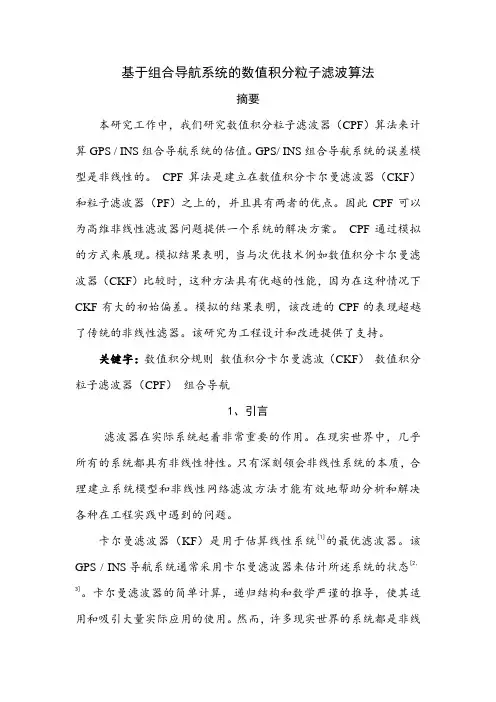
基于组合导航系统的数值积分粒子滤波算法摘要本研究工作中,我们研究数值积分粒子滤波器(CPF)算法来计算GPS / INS组合导航系统的估值。
GPS/ INS组合导航系统的误差模型是非线性的。
CPF算法是建立在数值积分卡尔曼滤波器(CKF)和粒子滤波器(PF)之上的,并且具有两者的优点。
因此CPF可以为高维非线性滤波器问题提供一个系统的解决方案。
CPF通过模拟的方式来展现。
模拟结果表明,当与次优技术例如数值积分卡尔曼滤波器(CKF)比较时,这种方法具有优越的性能,因为在这种情况下CKF有大的初始偏差。
模拟的结果表明,该改进的CPF的表现超越了传统的非线性滤器。
该研究为工程设计和改进提供了支持。
关键字:数值积分规则数值积分卡尔曼滤波(CKF)数值积分粒子滤波器(CPF)组合导航1、引言滤波器在实际系统起着非常重要的作用。
在现实世界中,几乎所有的系统都具有非线性特性。
只有深刻领会非线性系统的本质,合理建立系统模型和非线性网络滤波方法才能有效地帮助分析和解决各种在工程实践中遇到的问题。
卡尔曼滤波器(KF)是用于估算线性系统[1]的最优滤波器。
该GPS / INS导航系统通常采用卡尔曼滤波器来估计所述系统的状态[2,3]。
卡尔曼滤波器的简单计算,递归结构和数学严谨的推导,使其适用和吸引大量实际应用的使用。
然而,许多现实世界的系统都是非线性的。
扩展卡尔曼滤波器(EKF)的开发来帮助这些非线性系统。
但是扩展卡尔曼滤波器是一种次优的非线性滤波器,由于当是线性系统[4,5]时截断了高阶项。
EKF的计算时间类似于卡尔曼滤波器[6]的。
数值积分卡尔曼滤波器(CKF)是没有非线性模型[7]的直链化非线性滤波连接的方法。
在CKF算法是公正和最小方差,这比GPS / INS 动态系统[8] EKF方法更好。
在CKF中被建议使用贬低线性偏置的非线性测量方程[9]。
物理系统往往受到意想不到的偏差或失误[10]。
其结果是,有一个方法,来维持一个精确的和可靠的解决方案[11]是重要的。
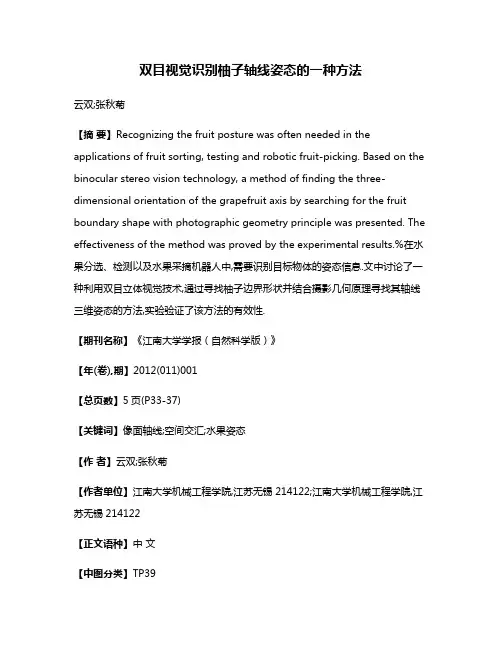
双目视觉识别柚子轴线姿态的一种方法云双;张秋菊【摘要】Recognizing the fruit posture was often needed in the applications of fruit sorting, testing and robotic fruit-picking. Based on the binocular stereo vision technology, a method of finding the three-dimensional orientation of the grapefruit axis by searching for the fruit boundary shape with photographic geometry principle was presented. The effectiveness of the method was proved by the experimental results.%在水果分选、检测以及水果采摘机器人中,需要识别目标物体的姿态信息.文中讨论了一种利用双目立体视觉技术,通过寻找柚子边界形状并结合摄影几何原理寻找其轴线三维姿态的方法,实验验证了该方法的有效性.【期刊名称】《江南大学学报(自然科学版)》【年(卷),期】2012(011)001【总页数】5页(P33-37)【关键词】像面轴线;空间交汇;水果姿态【作者】云双;张秋菊【作者单位】江南大学机械工程学院,江苏无锡214122;江南大学机械工程学院,江苏无锡214122【正文语种】中文【中图分类】TP39近年来,在水果品质自动检测、水果分级分选方面,机器视觉系统得到了越来越多的应用[1-4]。
在水果采摘、分拣和加工中应用机器人技术正在成为实现水果加工自动化的一大发展趋势,不仅可以改善水果加工卫生条件,还可以减轻劳动强度和提高劳动效率。
采用机械手取代人工操作,获取水果位姿信息是非常关键的。
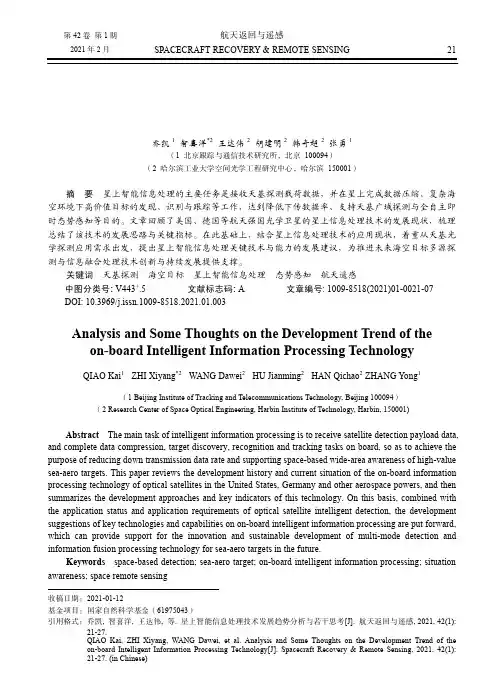
第42卷第1期航天返回与遥感2021年2月SPACECRAFT RECOVERY & REMOTE SENSING21星上智能信息处理技术发展趋势分析与若干思考乔凯1智喜洋*2王达伟2胡建明2韩奇超2张勇1(1 北京跟踪与通信技术研究所,北京 100094)(2 哈尔滨工业大学空间光学工程研究中心,哈尔滨 150001)摘要星上智能信息处理的主要任务是接收天基探测载荷数据,并在星上完成数据压缩、复杂海空环境下高价值目标的发现、识别与跟踪等工作,达到降低下传数据率、支持天基广域探测与全自主即时态势感知等目的。
文章回顾了美国、德国等航天强国光学卫星的星上信息处理技术的发展现状,梳理总结了该技术的发展思路与关键指标。
在此基础上,结合星上信息处理技术的应用现状,着重从天基光学探测应用需求出发,提出星上智能信息处理关键技术与能力的发展建议,为推进未来海空目标多源探测与信息融合处理技术创新与持续发展提供支撑。
关键词天基探测海空目标星上智能信息处理态势感知航天遥感中图分类号: V443+.5文献标志码: A 文章编号: 1009-8518(2021)01-0021-07DOI: 10.3969/j.issn.1009-8518.2021.01.003Analysis and Some Thoughts on the Development Trend of the on-board Intelligent Information Processing TechnologyQIAO Kai1 ZHI Xiyang*2 WANG Dawei2HU Jianming2 HAN Qichao2 ZHANG Yong1(1 Beijing Institute of Tracking and Telecommunications Technology, Beijing 100094)(2 Research Center of Space Optical Engineering, Harbin Institute of Technology, Harbin, 150001)Abstract The main task of intelligent information processing is to receive satellite detection payload data, and complete data compression, target discovery, recognition and tracking tasks on board, so as to achieve the purpose of reducing down transmission data rate and supporting space-based wide-area awareness of high-value sea-aero targets. This paper reviews the development history and current situation of the on-board information processing technology of optical satellites in the United States, Germany and other aerospace powers, and then summarizes the development approaches and key indicators of this technology. On this basis, combined with the application status and application requirements of optical satellite intelligent detection, the development suggestions of key technologies and capabilities on on-board intelligent information processing are put forward, which can provide support for the innovation and sustainable development of multi-mode detection and information fusion processing technology for sea-aero targets in the future.Keywords space-based detection; sea-aero target; on-board intelligent information processing; situation awareness; space remote sensing收稿日期:2021-01-12基金项目:国家自然科学基金(61975043)引用格式:乔凯, 智喜洋, 王达伟, 等. 星上智能信息处理技术发展趋势分析与若干思考[J]. 航天返回与遥感, 2021, 42(1): 21-27.QIAO Kai, ZHI Xiyang, WANG Dawei, et al. Analysis and Some Thoughts on the Development Trend of the on-board Intelligent Information Processing Technology[J]. Spacecraft Recovery & Remote Sensing, 2021, 42(1): 21-27. (in Chinese)22航天返回与遥感2021年第42卷0 引言基于卫星平台的天基光学探测具有观测范围广、空间与时间分辨率高、可全天候工作等独特优势,已成为海空目标精准识别、持续监视的必要手段,是实现广域海空监管的有效途径,在交通运输、海洋执法、国防安全等领域有着重要应用[1]。
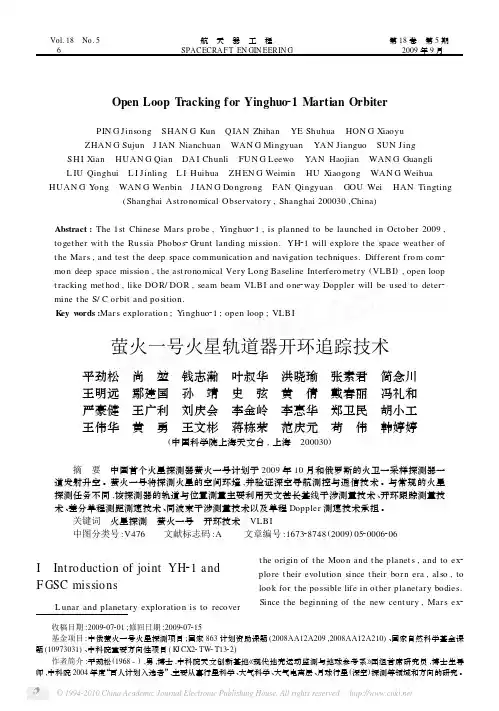
Vol.18 No.5 6 航 天 器 工 程SPACECRA FT EN GIN EERIN G 第18卷 第5期 2009年9月Open Loop T racking for Yinghuo 21Martian OrbiterPIN G Jinsong SHAN G Kun Q IAN Zhihan YE Shuhua HON G Xiaoyu ZHAN G Sujun J IAN Nianchuan WAN G Mingyuan YAN Jianguo SUN Jing SHI Xian HUAN G Qian DA I Chunli FUN G Leewo YAN Haojian WAN G Guangli L IU Qinghui L I Jinling L I Huihua ZH EN G Weimin HU Xiaogong WAN G Weihua HUAN G Y ong WAN G Wenbin J IAN G Dongrong FAN Qingyuan GOU Wei HAN Tingting(Shanghai Ast ronomical Observatory ,Shanghai 200030,China )Abstract :The 1st Chinese Mars p robe ,Y inghuo 21,is planned to be launched in Octo ber 2009,toget her wit h t he Russia Phobos 2Grunt landing mission.YH 21will explore t he space weat her of t he Mars ,and test t he deep space communication and navigation techniques.Different f rom com 2mon deep space mission ,t he ast ronomical Very Long Baseline Interferometry (VLBI ),open loop t racking met hod ,like DOR/DOR ,seam beam VLBI and one 2way Doppler will be used to deter 2mine t he S/C orbit and position.K ey w ords :Mars exploration ;Y inghuo 21;open loop ;VLB I收稿日期:2009207201;修回日期:2009207215基金项目:中俄萤火一号火星探测项目;国家863计划资助课题(2008AA12A209,2008AA12A210)、国家自然科学基金课题(10973031)、中科院重要方向性项目(K J CX22TW 2T1322)作者简介:平劲松(1968-),男,博士,中科院天文创新基地《现代地壳运动监测与地球参考系》团组首席研究员,博士生导师,中科院2004年度“百人计划入选者”,主要从事行星科学、大气科学、大气电离层、月球行星(深空)探测等领域和方向的研究。
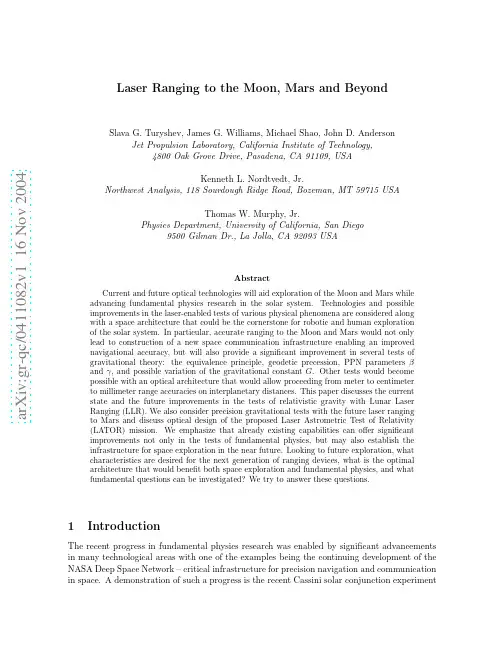
a r X i v :g r -q c /0411082v 1 16 N o v 2004Laser Ranging to the Moon,Mars and BeyondSlava G.Turyshev,James G.Williams,Michael Shao,John D.AndersonJet Propulsion Laboratory,California Institute of Technology,4800Oak Grove Drive,Pasadena,CA 91109,USAKenneth L.Nordtvedt,Jr.Northwest Analysis,118Sourdough Ridge Road,Bozeman,MT 59715USA Thomas W.Murphy,Jr.Physics Department,University of California,San Diego 9500Gilman Dr.,La Jolla,CA 92093USA Abstract Current and future optical technologies will aid exploration of the Moon and Mars while advancing fundamental physics research in the solar system.Technologies and possible improvements in the laser-enabled tests of various physical phenomena are considered along with a space architecture that could be the cornerstone for robotic and human exploration of the solar system.In particular,accurate ranging to the Moon and Mars would not only lead to construction of a new space communication infrastructure enabling an improved navigational accuracy,but will also provide a significant improvement in several tests of gravitational theory:the equivalence principle,geodetic precession,PPN parameters βand γ,and possible variation of the gravitational constant G .Other tests would become possible with an optical architecture that would allow proceeding from meter to centimeter to millimeter range accuracies on interplanetary distances.This paper discusses the current state and the future improvements in the tests of relativistic gravity with Lunar Laser Ranging (LLR).We also consider precision gravitational tests with the future laser rangingto Mars and discuss optical design of the proposed Laser Astrometric Test of Relativity (LATOR)mission.We emphasize that already existing capabilities can offer significant improvements not only in the tests of fundamental physics,but may also establish the infrastructure for space exploration in the near future.Looking to future exploration,what characteristics are desired for the next generation of ranging devices,what is the optimal architecture that would benefit both space exploration and fundamental physics,and what fundamental questions can be investigated?We try to answer these questions.1IntroductionThe recent progress in fundamental physics research was enabled by significant advancements in many technological areas with one of the examples being the continuing development of the NASA Deep Space Network –critical infrastructure for precision navigation and communication in space.A demonstration of such a progress is the recent Cassini solar conjunction experiment[8,6]that was possible only because of the use of Ka-band(∼33.4GHz)spacecraft radio-tracking capabilities.The experiment was part of the ancillary science program–a by-product of this new radio-tracking technology.Becasue of a much higher data rate transmission and, thus,larger data volume delivered from large distances the higher communication frequency was a very important mission capability.The higher frequencies are also less affected by the dispersion in the solar plasma,thus allowing a more extensive coverage,when depp space navigation is concerned.There is still a possibility of moving to even higher radio-frequencies, say to∼60GHz,however,this would put us closer to the limit that the Earth’s atmosphere imposes on signal transmission.Beyond these frequencies radio communication with distant spacecraft will be inefficient.The next step is switching to optical communication.Lasers—with their spatial coherence,narrow spectral emission,high power,and well-defined spatial modes—are highly useful for many space applications.While in free-space,optical laser communication(lasercomm)would have an advantage as opposed to the conventional radio-communication sercomm would provide not only significantly higher data rates(on the order of a few Gbps),it would also allow a more precise navigation and attitude control.The latter is of great importance for manned missions in accord the“Moon,Mars and Beyond”Space Exploration Initiative.In fact,precision navigation,attitude control,landing,resource location, 3-dimensional imaging,surface scanning,formationflying and many other areas are thought only in terms of laser-enabled technologies.Here we investigate how a near-future free-space optical communication architecture might benefit progress in gravitational and fundamental physics experiments performed in the solar system.This paper focuses on current and future optical technologies and methods that will advance fundamental physics research in the context of solar system exploration.There are many activities that focused on the design on an optical transceiver system which will work at the distance comparable to that between the Earth and Mars,and test it on the Moon.This paper summarizes required capabilities for such a system.In particular,we discuss how accurate laser ranging to the neighboring celestial bodies,the Moon and Mars,would not only lead to construction of a new space communication infrastructure with much improved navigational accuracy,it will also provide a significant improvement in several tests of gravitational theory. Looking to future exploration,we address the characteristics that are desired for the next generation of ranging devices;we will focus on optimal architecture that would benefit both space exploration and fundamental physics,and discuss the questions of critical importance that can be investigated.This paper is organized as follows:Section2discusses the current state and future per-formance expected with the LLR technology.Section3addresses the possibility of improving tests of gravitational theories with laser ranging to Mars.Section4addresses the next logical step—interplanetary laser ranging.We discuss the mission proposal for the Laser Astrometric Test of Relativity(LATOR).We present a design for its optical receiver system.Section5 addresses a proposal for new multi-purpose space architecture based on optical communica-tion.We present a preliminary design and discuss implications of this new proposal for tests of fundamental physics.We close with a summary and recommendations.2LLR Contribution to Fundamental PhysicsDuring more than35years of its existence lunar laser ranging has become a critical technique available for precision tests of gravitational theory.The20th century progress in three seem-ingly unrelated areas of human exploration–quantum optics,astronomy,and human spaceexploration,led to the construction of this unique interplanetary instrument to conduct very precise tests of fundamental physics.In this section we will discuss the current state in LLR tests of relativistic gravity and explore what could be possible in the near future.2.1Motivation for Precision Tests of GravityThe nature of gravity is fundamental to our understanding of the structure and evolution of the universe.This importance motivates various precision tests of gravity both in laboratories and in space.Most of the experimental underpinning for theoretical gravitation has come from experiments conducted in the solar system.Einstein’s general theory of relativity(GR)began its empirical success in1915by explaining the anomalous perihelion precession of Mercury’s orbit,using no adjustable theoretical parameters.Eddington’s observations of the gravitational deflection of light during a solar eclipse in1919confirmed the doubling of the deflection angles predicted by GR as compared to Newtonian and Equivalence Principle(EP)arguments.Follow-ing these beginnings,the general theory of relativity has been verified at ever-higher accuracy. Thus,microwave ranging to the Viking landers on Mars yielded an accuracy of∼0.2%from the gravitational time-delay tests of GR[48,44,49,50].Recent spacecraft and planetary mi-crowave radar observations reached an accuracy of∼0.15%[4,5].The astrometric observations of the deflection of quasar positions with respect to the Sun performed with Very-Long Base-line Interferometry(VLBI)improved the accuracy of the tests of gravity to∼0.045%[45,51]. Lunar Laser Ranging(LLR),the continuing legacy of the Apollo program,has provided ver-ification of GR improving an accuracy to∼0.011%via precision measurements of the lunar orbit[62,63,30,31,32,35,24,36,4,68].The recent time-delay experiments with the Cassini spacecraft at a solar conjunction have tested gravity to a remarkable accuracy of0.0023%[8] in measuring deflection of microwaves by solar gravity.Thus,almost ninety years after general relativity was born,Einstein’s theory has survived every test.This rare longevity and the absence of any adjustable parameters,does not mean that this theory is absolutely correct,but it serves to motivate more sensitive tests searching for its expected violation.The solar conjunction experiments with the Cassini spacecraft have dramatically improved the accuracy in the solar system tests of GR[8].The reported accuracy of2.3×10−5in measuring the Eddington parameterγ,opens a new realm for gravitational tests,especially those motivated by the on-going progress in scalar-tensor theories of gravity.1 In particular,scalar-tensor extensions of gravity that are consistent with present cosmological models[15,16,17,18,19,20,39]predict deviations of this parameter from its GR value of unity at levels of10−5to10−7.Furthermore,the continuing inability to unify gravity with the other forces indicates that GR should be violated at some level.The Cassini result together with these theoretical predictions motivate new searches for possible GR violations;they also provide a robust theoretical paradigm and constructive guidance for experiments that would push beyond the present experimental accuracy for parameterized post-Newtonian(PPN)parameters(for details on the PPN formalism see[60]).Thus,in addition to experiments that probe the GR prediction for the curvature of the gravityfield(given by parameterγ),any experiment pushingthe accuracy in measuring the degree of non-linearity of gravity superposition(given by anotherEddington parameterβ)will also be of great interest.This is a powerful motive for tests ofgravitational physics phenomena at improved accuracies.Analyses of laser ranges to the Moon have provided increasingly stringent limits on anyviolation of the Equivalence Principle(EP);they also enabled very accurate measurements fora number of relativistic gravity parameters.2.2LLR History and Scientific BackgroundLLR has a distinguished history[24,9]dating back to the placement of a retroreflector array onthe lunar surface by the Apollo11astronauts.Additional reflectors were left by the Apollo14and Apollo15astronauts,and two French-built reflector arrays were placed on the Moon by theSoviet Luna17and Luna21missions.Figure1shows the weighted RMS residual for each year.Early accuracies using the McDonald Observatory’s2.7m telescope hovered around25cm. Equipment improvements decreased the ranging uncertainty to∼15cm later in the1970s.In1985the2.7m ranging system was replaced with the McDonald Laser Ranging System(MLRS).In the1980s ranges were also received from Haleakala Observatory on the island of Maui in theHawaiian chain and the Observatoire de la Cote d’Azur(OCA)in France.Haleakala ceasedoperations in1990.A sequence of technical improvements decreased the range uncertainty tothe current∼2cm.The2.7m telescope had a greater light gathering capability than thenewer smaller aperture systems,but the newer systemsfired more frequently and had a muchimproved range accuracy.The new systems do not distinguish returning photons against thebright background near full Moon,which the2.7m telescope could do,though there are somemodern eclipse observations.The lasers currently used in the ranging operate at10Hz,with a pulse width of about200 psec;each pulse contains∼1018photons.Under favorable observing conditions a single reflectedphoton is detected once every few seconds.For data processing,the ranges represented by thereturned photons are statistically combined into normal points,each normal point comprisingup to∼100photons.There are15553normal points are collected until March2004.Themeasured round-trip travel times∆t are two way,but in this paper equivalent ranges in lengthunits are c∆t/2.The conversion between time and length(for distance,residuals,and dataaccuracy)uses1nsec=15cm.The ranges of the early1970s had accuracies of approximately25cm.By1976the accuracies of the ranges had improved to about15cm.Accuracies improvedfurther in the mid-1980s;by1987they were4cm,and the present accuracies are∼2cm.One immediate result of lunar ranging was the great improvement in the accuracy of the lunarephemeris[62]and lunar science[67].LLR measures the range from an observatory on the Earth to a retroreflector on the Moon. For the Earth and Moon orbiting the Sun,the scale of relativistic effects is set by the ratio(GM/rc2)≃v2/c2∼10−8.The center-to-center distance of the Moon from the Earth,with mean value385,000km,is variable due to such things as eccentricity,the attraction of the Sun,planets,and the Earth’s bulge,and relativistic corrections.In addition to the lunar orbit,therange from an observatory on the Earth to a retroreflector on the Moon depends on the positionin space of the ranging observatory and the targeted lunar retroreflector.Thus,orientation ofthe rotation axes and the rotation angles of both bodies are important with tidal distortions,plate motion,and relativistic transformations also coming into play.To extract the gravitationalphysics information of interest it is necessary to accurately model a variety of effects[68].For a general review of LLR see[24].A comprehensive paper on tests of gravitationalphysics is[62].A recent test of the EP is in[4]and other GR tests are in[64].An overviewFigure1:Historical accuracy of LLR data from1970to2004.of the LLR gravitational physics tests is given by Nordtvedt[37].Reviews of various tests of relativity,including the contribution by LLR,are given in[58,60].Our recent paper describes the model improvements needed to achieve mm-level accuracy for LLR[66].The most recent LLR results are given in[68].2.3Tests of Relativistic Gravity with LLRLLR offers very accurate laser ranging(weighted rms currently∼2cm or∼5×10−11in frac-tional accuracy)to retroreflectors on the Moon.Analysis of these very precise data contributes to many areas of fundamental and gravitational physics.Thus,these high-precision studies of the Earth-Moon-Sun system provide the most sensitive tests of several key properties of weak-field gravity,including Einstein’s Strong Equivalence Principle(SEP)on which general relativity rests(in fact,LLR is the only current test of the SEP).LLR data yielded the strongest limits to date on variability of the gravitational constant(the way gravity is affected by the expansion of the universe),and the best measurement of the de Sitter precession rate.In this Section we discuss these tests in more details.2.3.1Tests of the Equivalence PrincipleThe Equivalence Principle,the exact correspondence of gravitational and inertial masses,is a central assumption of general relativity and a unique feature of gravitation.EP tests can therefore be viewed in two contexts:tests of the foundations of general relativity,or as searches for new physics.As emphasized by Damour[12,13],almost all extensions to the standard modelof particle physics(with best known extension offered by string theory)generically predict newforces that would show up as apparent violations of the EP.The weak form the EP(the WEP)states that the gravitational properties of strong and electro-weak interactions obey the EP.In this case the relevant test-body differences are their fractional nuclear-binding differences,their neutron-to-proton ratios,their atomic charges,etc. General relativity,as well as other metric theories of gravity,predict that the WEP is exact. However,extensions of the Standard Model of Particle Physics that contain new macroscopic-range quantumfields predict quantum exchange forces that will generically violate the WEP because they couple to generalized‘charges’rather than to mass/energy as does gravity[17,18]. WEP tests can be conducted with laboratory or astronomical bodies,because the relevant differences are in the test-body compositions.Easily the most precise tests of the EP are made by simply comparing the free fall accelerations,a1and a2,of different test bodies.For the case when the self-gravity of the test bodies is negligible and for a uniform external gravityfield, with the bodies at the same distance from the source of the gravity,the expression for the Equivalence Principle takes the most elegant form:∆a= M G M I 2(1)(a1+a2)where M G and M I represent gravitational and inertial masses of each body.The sensitivity of the EP test is determined by the precision of the differential acceleration measurement divided by the degree to which the test bodies differ(position).The strong form of the EP(the SEP)extends the principle to cover the gravitational properties of gravitational energy itself.In other words it is an assumption about the way that gravity begets gravity,i.e.about the non-linear property of gravitation.Although general relativity assumes that the SEP is exact,alternate metric theories of gravity such as those involving scalarfields,and other extensions of gravity theory,typically violate the SEP[30,31, 32,35].For the SEP case,the relevant test body differences are the fractional contributions to their masses by gravitational self-energy.Because of the extreme weakness of gravity,SEP test bodies that differ significantly must have astronomical sizes.Currently the Earth-Moon-Sun system provides the best arena for testing the SEP.The development of the parameterized post-Newtonian formalism[31,56,57],allows one to describe within the common framework the motion of celestial bodies in external gravitational fields within a wide class of metric theories of gravity.Over the last35years,the PPN formalism has become a useful framework for testing the SEP for extended bodies.In that formalism,the ratio of passive gravitational to inertial mass to thefirst order is given by[30,31]:M GMc2 ,(2) whereηis the SEP violation parameter(discussed below),M is the mass of a body and E is its gravitational binding or self-energy:E2Mc2 V B d3x d3yρB(x)ρB(y)EMc2 E=−4.64×10−10andwhere the subscripts E and m denote the Earth and Moon,respectively.The relatively small size bodies used in the laboratory experiments possess a negligible amount of gravitational self-energy and therefore such experiments indicate nothing about the equality of gravitational self-energy contributions to the inertial and passive gravitational masses of the bodies [30].TotesttheSEP onemustutilize planet-sizedextendedbodiesinwhichcase theratioEq.(3)is considerably higher.Dynamics of the three-body Sun-Earth-Moon system in the solar system barycentric inertial frame was used to search for the effect of a possible violation of the Equivalence Principle.In this frame,the quasi-Newtonian acceleration of the Moon (m )with respect to the Earth (E ),a =a m −a E ,is calculated to be:a =−µ∗rM I m µS r SEr 3Sm + M G M I m µS r SEr 3+µS r SEr 3Sm +η E Mc 2 m µS r SEMc 2 E − E n 2−(n −n ′)2n ′2a ′cos[(n −n ′)t +D 0].(8)Here,n denotes the sidereal mean motion of the Moon around the Earth,n ′the sidereal mean motion of the Earth around the Sun,and a ′denotes the radius of the orbit of the Earth around the Sun (assumed circular).The argument D =(n −n ′)t +D 0with near synodic period is the mean longitude of the Moon minus the mean longitude of the Sun and is zero at new Moon.(For a more precise derivation of the lunar range perturbation due to the SEP violation acceleration term in Eq.(6)consult [62].)Any anomalous radial perturbation will be proportional to cos D .Expressed in terms ofη,the radial perturbation in Eq.(8)isδr∼13ηcos D meters [38,21,22].This effect,generalized to all similar three body situations,the“SEP-polarization effect.”LLR investigates the SEP by looking for a displacement of the lunar orbit along the direction to the Sun.The equivalence principle can be split into two parts:the weak equivalence principle tests the sensitivity to composition and the strong equivalence principle checks the dependence on mass.There are laboratory investigations of the weak equivalence principle(at University of Washington)which are about as accurate as LLR[7,1].LLR is the dominant test of the strong equivalence principle.The most accurate test of the SEP violation effect is presently provided by LLR[61,48,23],and also in[24,62,63,4].Recent analysis of LLR data test the EP of∆(M G/M I)EP=(−1.0±1.4)×10−13[68].This result corresponds to a test of the SEP of∆(M G/M I)SEP=(−2.0±2.0)×10−13with the SEP violation parameter η=4β−γ−3found to beη=(4.4±4.5)×10−ing the recent Cassini result for the PPN parameterγ,PPN parameterβis determined at the level ofβ−1=(1.2±1.1)×10−4.2.3.2Other Tests of Gravity with LLRLLR data yielded the strongest limits to date on variability of the gravitational constant(the way gravity is affected by the expansion of the universe),the best measurement of the de Sitter precession rate,and is relied upon to generate accurate astronomical ephemerides.The possibility of a time variation of the gravitational constant,G,wasfirst considered by Dirac in1938on the basis of his large number hypothesis,and later developed by Brans and Dicke in their theory of gravitation(for more details consult[59,60]).Variation might be related to the expansion of the Universe,in which case˙G/G=σH0,where H0is the Hubble constant, andσis a dimensionless parameter whose value depends on both the gravitational constant and the cosmological model considered.Revival of interest in Brans-Dicke-like theories,with a variable G,was partially motivated by the appearance of superstring theories where G is considered to be a dynamical quantity[26].Two limits on a change of G come from LLR and planetary ranging.This is the second most important gravitational physics result that LLR provides.GR does not predict a changing G,but some other theories do,thus testing for this effect is important.The current LLR ˙G/G=(4±9)×10−13yr−1is the most accurate limit published[68].The˙G/G uncertaintyis83times smaller than the inverse age of the universe,t0=13.4Gyr with the value for Hubble constant H0=72km/sec/Mpc from the WMAP data[52].The uncertainty for˙G/G is improving rapidly because its sensitivity depends on the square of the data span.This fact puts LLR,with its more then35years of history,in a clear advantage as opposed to other experiments.LLR has also provided the only accurate determination of the geodetic precession.Ref.[68]reports a test of geodetic precession,which expressed as a relative deviation from GR,is K gp=−0.0019±0.0064.The GP-B satellite should provide improved accuracy over this value, if that mission is successfully completed.LLR also has the capability of determining PPNβandγdirectly from the point-mass orbit perturbations.A future possibility is detection of the solar J2from LLR data combined with the planetary ranging data.Also possible are dark matter tests,looking for any departure from the inverse square law of gravity,and checking for a variation of the speed of light.The accurate LLR data has been able to quickly eliminate several suggested alterations of physical laws.The precisely measured lunar motion is a reality that any proposed laws of attraction and motion must satisfy.The above investigations are important to gravitational physics.The future LLR data will improve the above investigations.Thus,future LLR data of current accuracy would con-tinue to shrink the uncertainty of˙G because of the quadratic dependence on data span.The equivalence principle results would improve more slowly.To make a big improvement in the equivalence principle uncertainty requires improved range accuracy,and that is the motivation for constructing the APOLLO ranging facility in New Mexico.2.4Future LLR Data and APOLLO facilityIt is essential that acquisition of the new LLR data will continue in the future.Accuracies∼2cm are now achieved,and further very useful improvement is expected.Inclusion of improved data into LLR analyses would allow a correspondingly more precise determination of the gravitational physics parameters under study.LLR has remained a viable experiment with fresh results over35years because the data accuracies have improved by an order of magnitude(see Figure1).There are prospects for future LLR station that would provide another order of magnitude improvement.The Apache Point Observatory Lunar Laser-ranging Operation(APOLLO)is a new LLR effort designed to achieve mm range precision and corresponding order-of-magnitude gains in measurements of fundamental physics parameters.For thefirst time in the LLR history,using a3.5m telescope the APOLLO facility will push LLR into a new regime of multiple photon returns with each pulse,enabling millimeter range precision to be achieved[29,66].The anticipated mm-level range accuracy,expected from APOLLO,has a potential to test the EP with a sensitivity approaching10−14.This accuracy would yield sensitivity for parameterβat the level of∼5×10−5and measurements of the relative change in the gravitational constant,˙G/G, would be∼0.1%the inverse age of the universe.The overwhelming advantage APOLLO has over current LLR operations is a3.5m astro-nomical quality telescope at a good site.The site in southern New Mexico offers high altitude (2780m)and very good atmospheric“seeing”and image quality,with a median image resolu-tion of1.1arcseconds.Both the image sharpness and large aperture conspire to deliver more photons onto the lunar retroreflector and receive more of the photons returning from the re-flectors,pared to current operations that receive,on average,fewer than0.01 photons per pulse,APOLLO should be well into the multi-photon regime,with perhaps5–10 return photons per pulse.With this signal rate,APOLLO will be efficient atfinding and track-ing the lunar return,yielding hundreds of times more photons in an observation than current√operations deliver.In addition to the significant reduction in statistical error(useful).These new reflectors on the Moon(and later on Mars)can offer significant navigational accuracy for many space vehicles on their approach to the lunar surface or during theirflight around the Moon,but they also will contribute significantly to fundamental physics research.The future of lunar ranging might take two forms,namely passive retroreflectors and active transponders.The advantages of new installations of passive retroreflector arrays are their long life and simplicity.The disadvantages are the weak returned signal and the spread of the reflected pulse arising from lunar librations(apparent changes in orientation of up to10 degrees).Insofar as the photon timing error budget is dominated by the libration-induced pulse spread—as is the case in modern lunar ranging—the laser and timing system parameters do√not influence the net measurement uncertainty,which simply scales as1/3Laser Ranging to MarsThere are three different experiments that can be done with accurate ranges to Mars:a test of the SEP(similar to LLR),a solar conjunction experiment measuring the deflection of light in the solar gravity,similar to the Cassini experiment,and a search for temporal variation in the gravitational constant G.The Earth-Mars-Sun-Jupiter system allows for a sensitive test of the SEP which is qualitatively different from that provided by LLR[3].Furthermore,the outcome of these ranging experiments has the potential to improve the values of the two relativistic parameters—a combination of PPN parametersη(via test of SEP)and a direct observation of the PPN parameterγ(via Shapiro time delay or solar conjunction experiments).(This is quite different compared to LLR,as the small variation of Shapiro time delay prohibits very accurate independent determination of the parameterγ).The Earth-Mars range would also provide for a very accurate test of˙G/G.This section qualitatively addresses the near-term possibility of laser ranging to Mars and addresses the above three effects.3.1Planetary Test of the SEP with Ranging to MarsEarth-Mars ranging data can provide a useful estimate of the SEP parameterηgiven by Eq.(7). It was demonstrated in[3]that if future Mars missions provide ranging measurements with an accuracy ofσcentimeters,after ten years of ranging the expected accuracy for the SEP parameterηmay be of orderσ×10−6.These ranging measurements will also provide the most accurate determination of the mass of Jupiter,independent of the SEP effect test.It has been observed previously that a measurement of the Sun’s gravitational to inertial mass ratio can be performed using the Sun-Jupiter-Mars or Sun-Jupiter-Earth system[33,47,3]. The question we would like to answer here is how accurately can we do the SEP test given the accurate ranging to Mars?We emphasize that the Sun-Mars-Earth-Jupiter system,though governed basically by the same equations of motion as Sun-Earth-Moon system,is significantly different physically.For a given value of SEP parameterηthe polarization effects on the Earth and Mars orbits are almost two orders of magnitude larger than on the lunar orbit.Below we examine the SEP effect on the Earth-Mars range,which has been measured as part of the Mariner9and Viking missions with ranging accuracy∼7m[48,44,41,43].The main motivation for our analysis is the near-future Mars missions that should yield ranging data, accurate to∼1cm.This accuracy would bring additional capabilities for the precision tests of fundamental and gravitational physics.3.1.1Analytical Background for a Planetary SEP TestThe dynamics of the four-body Sun-Mars-Earth-Jupiter system in the Solar system barycentric inertial frame were considered.The quasi-Newtonian acceleration of the Earth(E)with respect to the Sun(S),a SE=a E−a S,is straightforwardly calculated to be:a SE=−µ∗SE·r SE MI Eb=M,Jµb r bS r3bE + M G M I E b=M,Jµb r bS。
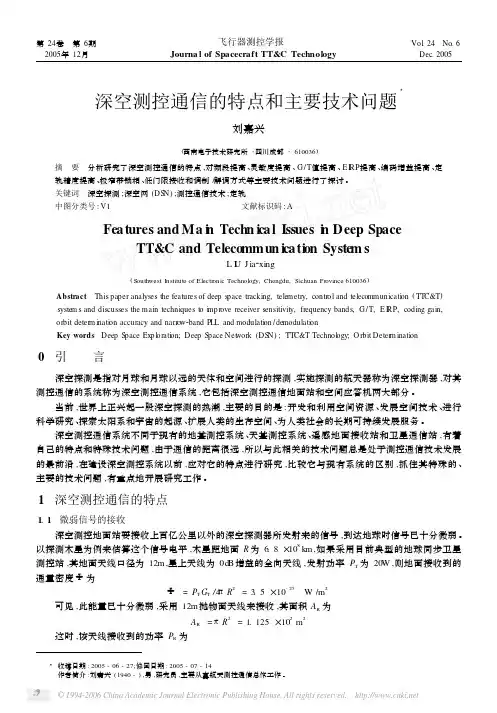
第24卷 第6期2005年12月 飞行器测控学报Journa l of Spacecraft TT&C Technology Vol.24 No.6Dec.2005深空测控通信的特点和主要技术问题3刘嘉兴(西南电子技术研究所・四川成都・610036)摘 要 分析研究了深空测控通信的特点,对频段提高、灵敏度提高、G/T值提高、E I RP提高、编码增益提高、定轨精度提高、极窄带锁相、低门限接收和调制/解调方式等主要技术问题进行了探讨。
关键词 深空探测;深空网(DS N);测控通信技术;定轨中图分类号:V1文献标识码:AFeatures and Ma i n Techn i cal Issues i n Deep SpaceTT&C and Teleco mmun i cati on Syste m sL I U J ia2xing(Southwest I nstitute of Electr onic Technol ogy,Chengdu,Sichuan Pr ovince610036)Abstract This paper analyses the features of deep s pace tracking,tele metry,contr ol and telecommunicati on(TTC&T)syste m s and discusses the main techniques t o i m p r ove receiver sensitivity,frequency bands,G/T,E I RP,coding gain,orbit deter m inati on accuracy and narr ow2band P LL and modulati on/demodulati on.Key words Deep Space Exp l orati on;Deep Space Net w ork(DS N);TTC&T Technol ogy;O rbit Deter m inati on0 引 言深空探测是指对月球和月球以远的天体和空间进行的探测,实施探测的航天器称为深空探测器,对其测控通信的系统称为深空测控通信系统,它包括深空测控通信地面站和空间应答机两大部分。
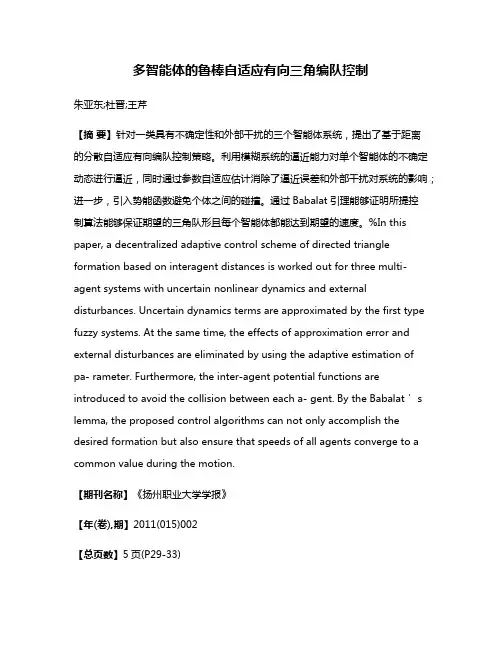
多智能体的鲁棒自适应有向三角编队控制朱亚东;杜晋;王芹【摘要】针对一类具有不确定性和外部干扰的三个智能体系统,提出了基于距离的分散自适应有向编队控制策略。
利用模糊系统的逼近能力对单个智能体的不确定动态进行逼近,同时通过参数自适应估计消除了逼近误差和外部干扰对系统的影响;进一步,引入势能函数避免个体之间的碰撞。
通过Babalat引理能够证明所提控制算法能够保证期望的三角队形且每个智能体都能达到期望的速度。
%In this paper, a decentralized adaptive control scheme of directed triangle formation based on interagent distances is worked out for three multi-agent systems with uncertain nonlinear dynamics and external disturbances. Uncertain dynamics terms are approximated by the first type fuzzy systems. At the same time, the effects of approximation error and external disturbances are eliminated by using the adaptive estimation ofpa- rameter. Furthermore, the inter-agent potential functions are introduced to avoid the collision between each a- gent. By the Babalat' s lemma, the proposed control algorithms can not only accomplish the desired formation but also ensure that speeds of all agents converge to a common value during the motion.【期刊名称】《扬州职业大学学报》【年(卷),期】2011(015)002【总页数】5页(P29-33)【关键词】多智能体系统;分散自适应控制;有向编队控制【作者】朱亚东;杜晋;王芹【作者单位】扬州职业大学,江苏扬州225009;扬州职业大学,江苏扬州225009;扬州职业大学,江苏扬州225009【正文语种】中文【中图分类】TP27320世纪90年代后期,多智能体的编队控制研究获得了深入的发展,相关研究成果在协同搜寻、营救、导航和多机器人规划、水下航行器控制及空间航行器的控制方面发挥了很大的作用[1-3]。
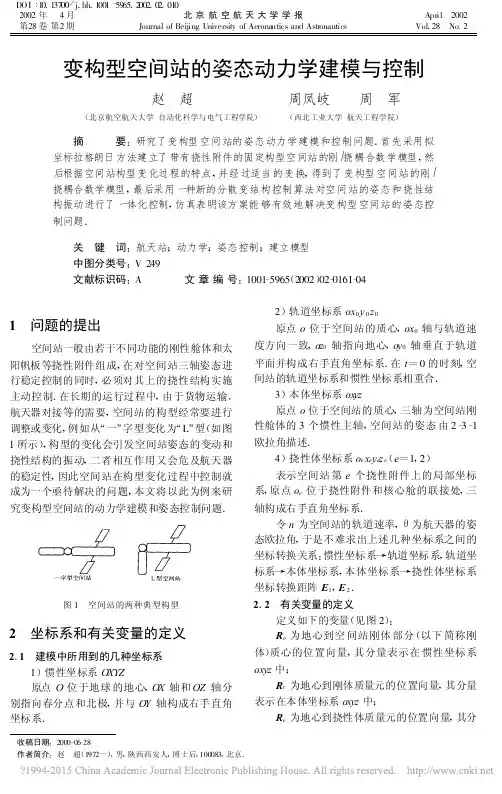
第28卷第
1期
2022年 2月
载人航天Manned Spaceflight
Vol.28 No.1Feb. 2022
基于改进GRA-TOPSIS法的飞行员进近着陆操纵绩效评价
陈农田,李俊辉,
满永政
(中国民用航空飞行学院,广汉618307)
摘要:
为准确评价飞行员进近着陆操纵绩效,有效发现飞行员操纵行为偏差及识别风险,借鉴
民航飞行运行作风要求咨询通告(AC-121-FS-2018-130
)
等文献,
结合航空公司采集的QAR数
据进行修正,建立飞行员进近着陆操纵绩效评估指标体系。运用群决策相对熵集结法、熵权值
法确定指标体系权重,改进GRA-TOPSIS算法以相对贴进度形式评价飞行员进近着陆操纵绩
效。通过实例计算验证该方法的适用性,并通过雷达图分析方法表征飞行员进近着陆操纵绩 效差异。结果显示:基于改进GRA-TOPSIS评价方法可以客观反映权重数值,有效评价飞行员
进近着陆操纵绩效,并有效识别飞行行为偏差
。
关键词:
飞行品质监控(FOQA);绩效评估;进近着陆;组合赋权法;GRA-TOPSIS法
中图分类号:X949 文献标识码:
A 文章编号:
1674-5825( 2022)
01-0040-07
Evaluation of Pilot Approach Landing Performance Based on
Improved GRA-Topsis Method
CHEN Nongtian
, LI Junhui, MAN Yongzheng
(Civil Aviation Flight University of China, Guanghan 618307,China)
Abstract: To accurately evaluate the pilot's approach and landing control performance, to
effectively discover
the pilot' s control behavior deviation and to identify the risks, a pilot approach
第48卷㊀第3期2022年6月空间控制技术与应用Aerospace Control and ApplicationVol.48㊀No.3Jun.㊀2022http //㊀acabice@引用格式:王典军,武冠群,韩璐,等.美国GSSAP 卫星观测模式分析与研究[J ].空间控制技术与应用,2022,48(3):22-28.WANG DJ ,WU G Q ,HAN L ,et al.Analysis and research on GSSAP observation [J ].Aerospace Control and Application ,2022,48(3):22-28(in Chinese ).doi :10.3969/j.issn.1674-1579.2022.03.003美国GSSAP 卫星观测模式分析与研究王典军,武冠群,韩㊀璐,经姚翔,刘崇华,尚霄宇北京空间飞行器总体设计部,北京100094摘㊀要:本文针对美国太空部队部署在GEO 的态势感知卫星GSSAP 的设计和在轨运行模式进行了分析,包括近年来GSSAP 轨道数据统计以及GSSAP 典型观测场景分析,提炼出漂移巡视㊁机动巡视与抵近等在轨运行的策略.同时针对提炼的三种策略开展仿真,比较不同工况下的效能,并分析不同倾角目标对卫星机动能力的需求,为我国未来在轨服务㊁空间碎片监测任务技术发展提供借鉴.关键词:GSSAP 卫星;巡视观测;抵近观测;机动策略中图分类号:V11㊀㊀㊀文献标志码:A㊀㊀㊀文章编号:1674-1579(2022)03-0022-07收稿日期:2022-05-09;录用日期:2022-06-05基金项目:国家自然科学基金资助项目(12102460)∗通信作者:E-mail:wdj.home@0㊀引㊀言地球同步轨道(GEO)是太空中的战略要地,其上运行着各国的高价值核心太空系统,因此对GEO 目标的观测尤为重要.美国曾于2006年秘密发射了2颗 微卫星技术试验 (MiTEx)卫星,演示验证了地球同步轨道巡视卫星技术.美空军在MiTEx 卫星基础上提出了 地球同步轨道空间态势感知计划 (geosynchronous space situational awareness program,GSSAP),与低轨SBSS 卫星构成综合天基空间目标监视体系,大幅提升高轨目标的探测精度和频度,获取目标的技术情报,分析目标用途,判断空间活动意图.GSSAP 项目一直被美军严格保密,直到2014年2月,美国空军航天司令部司令谢尔顿在一次讲话中高调宣布,美军将在2014年发射2颗GSSAP 卫星,外界才知晓其存在.但当问及公开的原因时,谢尔顿将军称, 希望表明我们实际上正在观察GEO 轨道上发生了什么 非常近地观察.它将有望产生威慑和劝阻影响 .美军并未公开卫星技术途径与载荷参数等核心信息,仍处于保密状态.GSSAP 卫星日常运行在近地球同步轨道,利用与地球同步轨道的相对漂移进行轨道巡视,对目标进行探测㊁编目和精确侦察,必要时还能通过轨道机动抵近地球同步轨道目标进行抵近详查,获取目标高清图像[1-3].世界安全基金会发布的‘全球太空对抗能力:开源评估“数据称,GSSAP 卫星自2014年以来已被监测到实施了数百次机动,并对数十颗GEO 卫星实施了抵近操作,采用方式为多次快速㊁小幅轨道机动.本文针对GSSAP 卫星设计进行了分析,并深入分析了GSSAP 卫星机动策略,相关研究可用于我国后续在轨服务㊁空间碎片监测与清除任务.1㊀GSSAP 卫星简介1.1㊀航天器概况GSSAP 是美国空军部署在地球同步轨道的最新一代空间态势感知卫星,主承包商轨道科学公司(orbital sciences corporation).星上搭载光电成像传第3期王典军等:美国GSSAP 卫星观测模式分析与研究感器,能够近距离对部署在同步轨道带上的航天器进行精确跟踪和特征识别.卫星具备GEO 巡视探测和抵近详查能力,可提供准确的太空目标轨道和特征数据,增强美国高轨态势感知能力[4-6].目前GSSAP 卫星六星在轨,两颗一组分别在2014年7月28日㊁2016年8月19日㊁2022年1月22日发射.截止2022年4月17日,根据公布数据,GSSAP-1目前轨道半长轴为43179km (GEO +1015km),倾角为1.44ʎ;GSSAP-2目前轨道半长轴为42490km (GEO +326km),倾角为0.75ʎ,推测GSSAP-1/2两颗星处于退役再利用状态.GSSAP-3和GSSAP-4目前轨道的半长轴大多数时间在GEO ʃ50km,倾角在0.3ʎ以内,地理经度大多数时间在东经10ʎ到180ʎ范围内,对亚太区域GEO 带航天器有一定威胁.GSSAP-5和GSSAP-6发射任务为美国天军任务-8(USSF-8),采用宇宙神-5(511)火箭,2022年1月22日从佛罗里达州卡纳维拉尔角发射场天军站一箭双星发射,其有效载荷为2颗GSSAP 卫星(GSSAP-5和GSSAP-6).火箭上面级3次点火直接将两颗卫星送入准地球同步轨道,到达轨道后,依次释放GSSAP-5和GSSAP-6卫星.图1㊀宇宙神-5(511)火箭飞行过程示意图Fig.1㊀Atlas V-511flight process diagram1.2㊀在轨应用概述2014年7月28日,GSSAP-1/2卫星发射后,进入地球静止轨道附近的运行轨道,轨道倾角0.5ʎ,并在地球静止带上方和下方漂移.入轨初期在轨测试阶段每天移动2.36ʎ,漂移周期大概154天,可观测位于GEO 轨道上的所有卫星.2016年8月,美空军调用一颗GSSAP 卫星进行机动变轨,抵近详查美海军发射时遇到故障的 移动用户目标系统-5 (MUOS-5)卫星以确定其故障原因,美军方也是在这次事件中首次公开承认GSSAP 具有交会对接能力.由俄罗斯科学院控制的ISON 太空空间监测网络公开的数据表明,自2014年以来,GSSAP 卫星进行了数百次机动,在地球同步轨道上以10~15km 的距离靠近了12颗正在运行中的卫星或为接近它们实施变轨机动.这些卫星包括俄罗斯民用航天器 Ekspress-AM8 (2017年7月)和 光线 (2017年9月)以及军用卫星 钟声 (俄罗斯代号 宇宙-2520 ,2017年10月), 彩虹-1M3 号(2017年11月), 彩虹-1M2 号(2018年5月).图2㊀俄罗斯发布的GSSAP 侦察图Fig.2㊀GSSAP investigation map released by Russia此外,GSSAP 卫星于2016年9月靠近中国通信技术试验卫星一号,并于2017年9月接近巴基斯坦Paksat-1R 和尼日利亚Nigcomsat-1R 卫星[7].1.3㊀GSSAP 卫星设计研判关于GSSAP 卫星设计细节尚未公布,但根据其运载㊁应用方式㊁少数公开图像等信息,可对GSSAP 卫星设计进行合理研判.GSSAP-1~GSSAP-4由Delta4-M +(4,2)火箭发射[1-7],该型火箭整流罩直径4m,长11.75m,考虑GSSAP 卫星以一箭双星的方式并排安装在整流罩内,如图2所示,则GSSAP 卫星本体的几何外形尺寸约为1m ˑ1m 左右.经调研,Delta4-M +(4,2)运载送入GEO 轨道的能力2208kg;ANGELS 卫星质量约为70-100kg;星箭对接环(PAF)的质量为240-418kg,次级载荷分配器(ESPA )的质量为181kg;可得单颗GSSAP 卫星的质量约为650-700kg [2].轨道科学公司在90年代末推出了GEOStar-1和GEOStar-2卫星平台,推测GSSAP 卫星采用了GEOStar-1平台.GEOStar-1平台是GEO 轨道(兼顾MEO)任务设计的紧凑型敏捷高性能平台,设计寿命5-8年;可承载有效载荷150kg [2],平台功率500-1500W,采用310s 比冲的双组元主发动机,位置保持可采用单组元推进模式,总速度增量不低㊃32㊃空间控制技术与应用第48卷于1000m /s [2];根据公开图像资料,GSSAP 卫星采用双翼太阳阵构型且在太阳阵展开三角架上粘贴电池片,估算帆板总面积约6m 2,整星峰值功耗预估不超过1200W.GEOStar-1平台资料显示,载荷数据下行链路采用X 频段(可选Ka 频段),最大下传速率100Mbps.外网公布的GSSAP 卫星图像资料显示安装有反射面天线,用于光学图像数据的下传.GSSAP 卫星在同步轨道巡视,经度位置不确定,为了满足对地数传的要求,数传天线指向范围至少需要半球指向范围.GSSAP 图像显示数传天线与本体相距较远,转动范围满足较大指向范围要求.GSSAP 卫星从外形观察为一体结构,推测光学相机未安装转台,对目标跟踪均采用平台机动.卫星姿态确定采用星敏加陀螺模式,姿态指向精度0.023ʎ;姿态控制采用反作用轮,姿态机动速度1.0(ʎ)/s;姿态抖动最大为1μrad.采用GPS 接收机实现测轨功能,位置精度小于50m.GSSAP-1~GSSAP-4为清晰观测空间目标,多次抵近目标25km 内[7-8],说明其光学载荷成像分辨率不高.成像相机视场通常较小(保证成像分辨率),为确保任务期间对目标的快速捕获,通过安装大视场捕获相机用于对目标的捕获跟踪.由于光学观测存在阳光规避角的问题,GSSAP 对目标观测通常为顺光,后期GSSAP 观测或测量可能考虑非光学设备或者采用规避角更小的观测设备.图3㊀GSSAP 一箭双星运载布局示意图Fig.3㊀GSSAP carriage layoutdiagram图4㊀GEOStar-1卫星平台Fig.4㊀GEOStar-1satellite platform2GSSAP 机动模式分析研究2.1㊀GSSAP 卫星运行轨道分析在轨长期运行期间,GSSAP 卫星运行于GEO 轨道,轨道高度在GEO ʃ50km 以内变化,形成相对GEO 轨道的向西漂移或向东漂移的巡视模式[9].GSSAP-5和GSSAP-6发射前,GSSAP 四星在轨分工明确:GSSAP-1早期执行全球巡视详察,目前已位于坟墓轨道;GSSAP-2早期执行东经120ʎ到西经0ʎ的区域巡视控守,目前全球区域漂移;GSSAP-3执行东经0ʎ到东经100ʎ的区域巡视控守;GSSAP-4执行东经50ʎ到东经180ʎ的区域巡视控守.根据公布的轨道数据,分析近3年GSSAP-3㊁GSSAP-4的轨道变化情况如图5所示.图5㊀近3年GSSAP-3和GSSAP-4轨道变化情况Fig.5㊀GSSAP-3和GSSAP-4orbit changes in recent 3years2.2㊀GSSAP 卫星机动策略分析结合GSSAP-4的轨道变化情况,分析GSSAP-4㊃42㊃第3期王典军等:美国GSSAP 卫星观测模式分析与研究对空间某一目标抵近观测过程.初始时刻GSSAP-4利用轨道高度差漂移接近目标;后期,GSSAP-4通过多次轨道机动抵近目标,并调整接近目标时光照条件.根据轨道数据分析,GSSAP-4轨道半长轴(42214km ң42197km ң42192km)逐渐减小,并调整轨道偏心率,逐渐接近目标.图6㊀GSSAP-4对空间某一目标抵近观测Fig.6㊀GSSAP-4approach observation for a space target在在轨服务㊁空间碎片监测与清除任务中,可借鉴GSSAP 对GEO 卫星的巡视观测方式,用于对GEO 带被服务卫星或空间碎片的巡视观测与外形检查.通过设置轨道高度,使任务卫星处于高于或低于GEO 的准同步轨道,整体上处于西漂或东漂状态,在漂移过程中对被服务卫星或空间碎片开展巡视监测.采用燃料最优方式实现GEO 轨道调整需要消耗速度增量如式(1)所示,其中,a 1与a 2分别为轨道调整前后的半长轴.ΔV =μa 1()㊃2a 2a 1+a 2-1+μa 2()㊃1-2a 1a 1+a 2(1)图7㊀漂移巡视示意图Fig.7㊀The drifting patrol为进一步加快观测效果与效率,可借鉴GSSAP 卫星小幅机动策略,提出机动巡视策略,即在任务卫星东漂或西漂过程中,在观测目标前后调整轨道高度,保证观测每个目标为顺光且距离合适.同时,通过该策略可调整任务时间,调整相对于目标的漂移速度,保证对多目标监测满足时间约束.机动巡视策略要点具体如下:1)通过调整轨道高度,调整相对于目标的漂移速度,进而调整到达目标附近需要的时间;2)为了节省推进剂,轨道调整尽量只调整半长轴,形成椭圆轨道;3)通过选择合适的轨道机动时机,使卫星与目标近距离交会时具有良好的光照角(目标ң太阳矢量与目标ң卫星矢量的夹角);4)当目标倾角较大时,以目标升降交点作为卫星与目标近距离交会点,同时考虑到目标升降交点地方时随季节变化,交会点应随之调整.图8㊀机动巡视示意图Fig.8㊀The orbit maneuver patrol在巡视的基础上,为进一步对目标进行长时间㊁明确方位的详细观测,需要对目标进行指定位置的近距离接近.在该策略中,需要设定抵近任务卫星时间,通过双脉冲机动实现对目标的近距离抵近伴飞或绕飞,为后续的在轨加注或维护奠定基础.抵近策略计算如下所示,该策略不仅可用于单个目标点抵近机动,也可将上一次目标点作为初始点,实现多个目标点的抵近机动.图9㊀抵近机动示意图Fig.9㊀The orbit maneuvering patrol设任务卫星位置和速度为ρo =[x ㊀y ㊀z ]T ,̇ρo =[̇x ㊀̇y ㊀̇z ]T ,加速度为a =[a x ㊀a y ㊀a z ]T ,并标记初始时刻位置和速度为ρo (0)和̇ρo (0).在t 时刻任务卫星的位置和速度矢量表达式为ρo (t )=Φ1(t )ρo (0)+Φ2(t )̇ρo (0)+Φ3(t )a (2)̇ρo (t )=Φ4(t )ρo (0)+Φ5(t )̇ρo (0)+Φ6(t )a (3)式中,Φi (i =1,2, ,6)均为3ˑ3矩阵.㊃52㊃空间控制技术与应用第48卷为了能够让任务卫星在t =T 时到达对应的位置ρo (T ),假设任务卫星在t =0时刻的ρo (0)处,具备初始运动速度̇ρ+o (0):̇ρ+o (0)=Φ-12(T )(ρo (T )-Φ1(T )ρo (0)-Φ3(T )a )(4)现设任务卫星初始位置ρo (0),速度̇ρo (0)为̇ρ-o (0).其在该位置须有转移速度̇ρ+o (0),则应施加的脉冲Δv 0为Δv 0=̇ρ+o (0)-̇ρ-o (0)(5)在速度̇ρ+o (0)作用下,可得任务卫星到达ρo (T )的速度̇ρo (T )为̇ρo (T )=̇ρ-o (T )=Φ4(t )ρo (0)+Φ5(t )̇ρ+o(0)+Φ6(t )a (6)若在位置ρo (T )处需要的速度为̇ρ+o (T ),则第二次施加的脉冲Δv T 为Δv T =̇ρ+o (T )-̇ρ-o (T )(7)由此,实现了在T 时间内任务卫星以双脉冲转移方式接近被服务卫星[10-12].3 仿真分析本节针对漂移巡视效能㊁机动巡视效能与抵近效能㊁姿态机动能力需求进行仿真,为策略分析与应用提供参考.针对机动巡视,假设任务卫星位于GEO-50km,倾角0ʎ,经度53.5ʎ,巡视任务时间不大于7天.设置如下3个被观测目标,具体如下所示:目标1:倾角5.86ʎ,定点经度54.56ʎ;目标2:倾角0.01ʎ,定点经度56.82ʎ;目标3:倾角1.14ʎ,定点经度57.85ʎ.若采用GEO-50km 漂移,完成3个目标遍历需要7天时间,但不能保证对每个目标顺光观测,且观测距离均不小于50km.采用机动巡视,对于上述约4.5ʎ经度差目标,任务卫星需要用约7天完成巡视,总速度增量消耗量约为0.4m /s,任务星抵近每个目标时的相对运动轨迹如图10所示,机动过程中任务星半长轴与目标相对距离曲线如图11所示.从图12~14中任务星机动巡视观测不同目标的相对距离曲线与光照角曲线可以看出,在与目标最近距离处,任务星均可顺光对目标进行观测.与GEO-50km 漂移巡视相比,机动巡视与目标观测距离更近,且光照角度更小,具有更好的观测效果.图10㊀机动巡视场景Fig.10㊀Orbit maneuvering patrolscene图11㊀机动巡视仿真卫星半长轴与目标相对距离曲线Fig.11㊀The semimajor axis and relative distance oforbit maneuvering patrolscene图12㊀机动巡视仿真观测目标1相对距离曲线与光照角曲线Fig.12㊀The relative distance and angle (sun-target-missionsatellite)of orbit maneuvering patrol for target1图13㊀机动巡视仿真观测目标2相对距离曲线与光照角曲线Fig.13㊀The relative distance and angle (sun-target-missionsatellite)of orbit maneuver patrol for target2图14㊀机动巡视仿真观测目标3相对距离曲线与光照角曲线Fig.14㊀The relative distance and angle (sun-target-missionsatellite)of orbit maneuvering patrol for target 3㊃62㊃第3期王典军等:美国GSSAP 卫星观测模式分析与研究表1㊀不同巡视方式成像效果对比分析Tab.1㊀Comparison of imaging effects ofdifferent patrol methods观测目标机动巡视GEO-50km 漂移巡视最近距离/km 最近距离对应光照角/(ʎ)最近距离/km 最近距离对应光照角/(ʎ)目标181468046目标255>90435目标3106344833针对抵近效能,通过设置多个抵近点与不同任务时间,使任务卫星快速接近目标伴飞,分析卫星速度增量消耗如图15-16所示.抵近任务工况100ң50km (1h)100ң50km(2h)100ң80(1h)ң50km(1h)100ң80(1h)ң60(0.5h)ң50km(0.5h)速度消耗28m /s 14.4m /s34m /s38.3m /s图15㊀100ң50km(2h)抵近场景Fig.15㊀Proximity scene (100ң50km(2h))图16㊀100ң80(1h)ң50km(1h)抵近场景Fig.16㊀Proximity scene (100ң80(1h)ң50km(1h))㊀㊀为进一步分析卫星姿态机动能力的需求,针对不同倾角的GEO 目标进行分析,给出如下的仿真结果,当目标相对距离越近㊁倾角越大,则需要卫星的机动能力越高.表2㊀不同倾角目标相对角速度分析Tab.2㊀Analysis of relative angular velocities oftargets with different orbital inclinatioins目标轨道倾角/(ʎ)最近相对距离/km最大相对角速度/((ʎ)/s)0.530.10.05230.10.20430.10.40630.10.61830.10.811030.7 1.01236.9 1.01545.7 1.04㊀结㊀论本文针对美国态势感知卫星GSSAP 的总体设计和对空间目标观测机动模式进行分析,并对漂移巡视㊁机动巡视与抵近等策略开展仿真研究.本文的分析可为我国后续在轨服务㊁空间碎片监测提供技术基础.参㊀考㊀文㊀献[1]㊀刘海印,曹秀云,林飞.2016年美军空间态势感知能力建设及发展动向分析[J].中国航天,2017(2):9-12.[2]㊀刁华飞,张雅声.美国高轨态势感知卫星能力分析[J].航天电子对抗,2019,35(4):48-51.DIAO H F,ZHANG Y S.Analysis of US geosynchronous situational awareness satellite capability [J].AerospaceElectronic Warfare,2019,35(4):48-51.[3]㊀蒙波,黄剑斌,李志,等.美国高轨抵近操作卫星Mi-TEx 飞行任务及启示[J].航天器工程,2014(3):112-118.MENG B,HUANG J B,LI Z,et al.Introduction to A-merican approaching operation satellite MiTEx in geosta-tionary orbit and its inspiration[J].Spacecraft Engineer-ing,2014(3):112-118.[4]㊀宋博.美国 一箭三星 发射同步轨道空间态势感知卫星[J].国际太空,2014(11):61-63.[5]㊀Los Angeles Air Force Base.Geosynchronous space situ-ational awareness program (GSSAP)satellite[EB /OL].(2016-08-03).[2019-11-21].https:ʊwww.losange- /About-Us /FactSheets /Article /901960/geo-synchronous-space-situational-awareness-programgssap-satellite /[6]㊀陆震.美国空间态势感知能力的过去和现状[J].兵器装备工程学报,2016,37(1):1-8.LU Z.History and status of US space situational aware-ness [J].Journal of Sichuan Ordnance,2016,37(1):1-8.[7]㊀范志涵,蔡亚星,李凤簪.针对GEO 目标的美国天基态势感知技术发展研究[J].航天器工程,2019,28(6):87-95.FAN Z H,CAI Y X,LI F Z.Study on development of A-merican space-based situational awareness technology for GEO objects[J].Spacecraft Engineering,2019,28(6):87-95.[8]㊀宫经刚,宁宇,吕楠.美国高轨天基态势感知技术发展与启示[J].空间控制技术与应用,2021,47(1):㊃72㊃空间控制技术与应用第48卷1-7.GONG J G,NING Y,LYU N.Development and enlight-enment of space based situational awareness technologyfor high orbit in the United States[J].Aerospace Con-trol and Application,2021,47(1):1-7.[9]㊀李青,刘爱芳,王永梅,等.美国空间攻防体系发展与能力研究[J].航天器工程,2018,27(3):95-103.LI Q,LIU A F,WANG Y M,et al.Research on devel-opment and ability of american space offensive and de-fensive system[J].Spacecraft Engineering,2018,27(3):95-103.[10]㊀郭碧波,强文义,梁斌,等.近圆轨道航天器伴随飞行控制方法研究[J].宇航学报,2008,29(6):1871-1877.GUO B B,QIANG W Y,LIANG B,et al.Control strate-gy study of spacecraft adjoint flying in near circular orbit[J].Journal of Astronautics,2008,29(6):1871-1877.㊀[11]㊀ZHANG R,HAN C,CHEN H.Flyaround trajectoryand control scheme design[C]ʊAIAA/AAS Astrody-namics Specialist Conference.Washingtong D.C.,AIAA,2016:5508:1-12.[12]㊀何康乐,和兴锁,宋明,等.基于椭圆形参考轨道的航天器泪滴形绕飞轨道设计[J].西北工业大学学报,2012,30(1):145-148.HE K L,HE X S,SONG M,et al.designing teardrop-shaped diversion orbit of spacecraft based on elliptic ref-erence orbit[J].Journal of Northwestern PolytechnicalUniversity,2012,30(1):145-148.作者简介:王典军(1968 ),研究员,研究方向为航天器总体设计;武冠群(1990 ),工程师,研究方向为航天器任务分析与规划;韩璐(1984 ),高级工程师,研究方向为航天器总体设计;经姚翔(1980 ),研究员,研究方向为航天器总体设计;刘崇华(1962 ),研究员,研究方向为航天器总体设计;尚霄宇(1991 ),工程师,研究方向为电子工程.Analysis and Research on GSSAP ObservationWANG Dianjun∗,WU Guanqun,HAN Lu,JING Yaoxiang,LIU Chonghua,SHANG XiaoyuBeijing Institute of Spacecraft System Engineering,Beijing100094,ChinaAbstract:Geosynchronous Earth Orbit(GEO)is regarded as a strategic area in the space.Analysis is made based on the space situational satellites,GSSAP(geosynchronous space situational awareness program),which are de-ployed on GEO by the US space force.Strategies including drifting,maneuvering and conducting are extracted from GSSAP orbit elements history in recent years and analyzed based on GSSAP typical observation scenery.Simula-tions are conducted based on three provided maneuver strategies.Efficiency are compared under different conditions and the mobility requirement under different inclinations are analyzed.The analysis results can effectively support technical development in Chinese in orbit service and space debris detection.Keywords:GSSAP;drifty observation;proximity observation;maneuvering strategyReceived:2022-05-09;Accepted:2022-06-05Foundation item:Nabional Nature Science Foundation of China(12102460)∗Corresponding author.E-mail:wdj.home@㊃82㊃。
航天技术专业名词中英文对照表平安性safety拜科努尔发射场Байконуркосмодром备用着陆场alternate landing site舱外活动extravehicular activity测地卫星geodetic satellite测控通信网communication network for tracking, telemetering and control system测量飞机instrumentation aircraft超重医学hypergravity medicine乘员舱大气环境crew cabin atmosphere environment冲压式发动机ramjet engine重复利用运载火箭reusable launch vehicle垂直起降火箭vertical lift off and vertical landing rocket磁环境实验magnetism environment test单级入轨火箭single stage to orbit rocket单组元火箭发动机mono propellant rocket engine导航卫星navigation satellite导航卫星系统navigation satellite system“导航星”全世界定位系统Navstar global positioning system,GPS 登月舱lunar module等效性原理的卫星实验satellite test of the equivalence principle,STEP低轨道low earth orbit低轨道运载火箭low earth orbit launch vehicle地面模拟飞行实验ground simulated flight test地球辐射带radiation belts of earth地球观测系统Earth Observing System,EOS地球同步轨道geosynchronous orbit地球信息系统Earth Observation System Data and Information System,EOSDIS地球资源卫星earth resources satellite地外文明extraterrestrial civilization电磁相容性实验electromagnetic compatibility test电弧加热设备arc heater电火箭发动机electric rocket engine动力学环境实验dynamics environment test对地观测技术earth observation technique多级入轨火箭multi-stage to-orbit rocket俄罗斯航天测控网Russian spacecraft tracking, telemetering and control network俄罗斯全世界导航卫星系统Russian global navigation satellite system,GLONASS发射操作launch operation反物质火箭antimatter rocket返回与再入return and reentry精湛声速空气动力学hypersonic aerodynamics跟踪与数据中继卫星tracking and data relay satellite固体火箭solid propellant rocket固液火箭hybrid rocket光学跟踪测量系统optical tracking system轨道机动orbit maneuver轨道转移火箭orbit transfer rocket哈勃空间望远镜Hubble Space Telescope,HST海洋卫星seasat航天space flight航天测控网spacecraft tracking, telemetering and control network航天测控系统spacecraft tracking, telemetering and control system航天测控站space tracking, telemetering and control station航天测量船spacecraft tracking, telemetering and control ship航天测量数据处置系统space tracking and telemetering data processing system航天飞机space plane航天飞行训练模拟器space flight training simulator航天服spacesuit航天工效学space ergonomics航天环境医学space environmental medicine航天基础设施space infrastructure航天经济学space economics航天救生医学space lifesaving medicine航天操纵中心space flying control center航天免疫功能与内分泌障碍space immune function and endocrine decompensation航天器spacecraft航天器供配电系统spacecraft power system航天器回收系统spacecraft recovery system航天器结构系统structural system of spacecraft航天器热控系统spacecraft thermal control system航天器设计、制造与实验design, manufacture and test of spacecraft 航天器通信与测控系统spacecraft communication, telemetering, command and tracking system航天器推动系统spacecraft propulsion system航天器信息治理系统spacecraft information management system航天器有效载荷系统spacecraft payload system航天器制导、导航与操纵系统spacecraft guidance, navigation and control system航天食物space flight food航天适应与再适应space adaptation and readaptation航天系统工程space system engineering航天系统全寿命费用life cycle cost of space system航天运输系统space transportation system航天振动实验设备space dynamic test facility核火箭发动机nuclear rocket engine红外天文学infrared astronomy化学火箭chemical rocket回归轨道recursive orbit火箭大型地面实验major ground testing of launch vehicle火箭的发射轨道ascent trajectory of launch vehicle火箭的靠得住性保证reliability assurance of launch vehicle火箭地面设备ground support system of launch vehicle火箭箭体结构rocket structure火箭研制程序development program of launch vehicle火箭研制与生产development and production of launch vehicle火箭遥测telemetry of launch vehicle火箭制导与操纵系统guidance, navigation and control system of launch vehicle火星探讨exploring Mars技术实验卫星technology experiment satellite交会对接rendezvous and docking近临界点现象near critical point phenomena进入entry酒泉卫星发射中心Jiuquan Satellite Launch Center靠得住性relibility肯尼迪航天中心Kennedy Space Center空间材料科学与加工space materials science and processing 空间蛋白质晶体生长protein crystal growth in space空间地球科学space earth science空间对地观测earth observation from space空间法space law空间辐射生物学space radiation biology空间环境模拟space environmental simulation空间环境探测卫星space environment exploration satellite 空间机械人space robot空间救生艇space emergency boat空间科学space science空间目标监视系统space surveillance system空间生命科学space life science空间生物加工biology processing in space空间碎片space debris空间太阳能发电站space solar power station空间探测space probe空间天气预报space weather forecast空间天文学space astronomy空间物理space physics空间细胞培育cell cultivation in space空间医学实验space medical experiment空间应用space application空间资源space resource空天飞机aerospace plane脉冲风洞impulse wind tunnel美国航天测控网United States Spacecraft Tracking, Telemetering and Control Networks齐奥尔科夫斯基公式ЦиолковскогоФормула气动辅助变轨aero-assist changing orbit气动热力学aerothermodynamics气象卫星meteorological satellite全世界转变global change热平稳实验thermal balancing test热真空实验thermal vacuum test人工重力artificial gravity人造地球卫星artificial earth satellite入轨injection三组元火箭发动机tri-propellant rocket engine失重生理学weightlessness physiology时刻统一系统timing system受控生态生命保障系统controlled ecological life support system 双组元火箭发动机bi-propellant rocket engine太阳同步轨道sun-synchronous orbit太阳系与日球探测solar system and heliosphere exploration太阳耀斑solar flare太原卫星发射中心Taiyuan Satellite Launch Center逃逸救生实验escape and rescue test天地来回运输系统earth to orbit and return transportation system 天空实验室Skylab天文卫星space astronomical satellite停泊轨道parking orbit通信卫星communications satellite微波统一系统unified microwave system微重力科学microgravity science微重力流体力学microgravity fluid mechanics微重力燃烧microgravity combustion卫星星座Satellite constellation卫星应用satellite application无人航天器unmanned spacecraft无线电跟踪测量系统radio tracking system西昌卫星发射中心Xichang Satellite Launch Center吸气式火箭airbreathing rocket星际火箭interplanetary rocket行星际探测器interplanetary probe行星探测exploring planet行星引力辅助变轨planetary gravity assist changing orbit遥科学telescience应急着陆区emergency landing zone应用卫星applied satellite宇宙速度cosmic velocity预警卫星early warning satellite月球车lunar roving vehicle月球探测lunar exploration月球探测器lunar probe月球站moon station运货飞船cargo transportation capsule运载火箭launch rocket运载器launch vehicle载人飞船manned capsule载人航天manned space flight载人航天器舱外活动系统extra-vehicular-activity system for manned space vehicle载人航天器发射manned space vehicle launch载人航天器发射场launch complex for manned space vehicle载人航天器环境操纵与生命保障系统environ-mental control and life support system for manned spacecraft载人航天器救生系统manned space vehicle escape and rescue system 载人航天器居住系统habitation system for manned spacecraft载人航天器仪表与照明系统instrumentation and lighting system for manned spacecraft侦查卫星reconnaissance satellite中国航天测控网China Spacecraft Tracking, Telemetering and Control Network重力生物学gravitational biology转移轨道transfer orbit着陆场landing site紫外天文学ultraviolet astronomy自由飞弹道靶free flight rangeX射线天文学X-ray astronomy)γ射线天文学γ-ray astronomy液体火箭liquid propellant rocket一次利用运载火箭expendable launch vehicle。
ATTITUDE TRACKING CONTROL FOR SPACECRAFT FORMATION FLYINGMatthew R.Long and Christopher D.HallAerospace and Ocean EngineeringVirginia Polytechnic Institute and State UniversityABSTRACTWe develop a non-linear tracking control law to be applied to formationflying spacecraft.Each spacecraft in the formation is modeled as a rigid body with axisymmetric wheels controlled by axial torques,and the kinematics are represented by Modified Rodriques Parameters(MRPs).The paperfirst derives the open-loop reference attitude, rate,and acceleration commands for tracking a moving object with the sensor boresight vector defined along a body-fixed axis.The reference trajectory is constructed so that the solar panel normal is aligned with the sun vector at all times while tracking targets on the rotating earth.The controller makes the body frame asymptotically track the reference motion when there are initial errors in the position and angular rates.A simple target tracking example is presented to demonstrate that the controller will allow each spacecraft in the formation to track the target and the sun simultaneously.INTRODUCTIONThe formationflying concept has become a topic of interest in recent years.Gramling et al.1discussed the On-board Navigation System(ONS)for relative navigation of the Earth-Observing-1(EOS-1)/Landsat-7(L-7)formation. The performance of the ONS was investigated in terms of tracking measurement type and quality,tracking frequency, and the relative orbital geometry of the formation.DeCou2presented a station-keeping strategy for formationflying interferometry.He discussed the basic orbital configuration for interferometry missions and the thrust requirements for station-keeping of a two-satellite formation.The work done by Ulybyshev3pertains to station-keeping of a con-stellation using a linear-quadratic regulator for feedback control.The controller minimized the along-track relative displacements between spacecraft and the orbital period displacements relative to a reference orbit.Folta et al.4also addressed separations between spacecraft in a formation.The performance of a formation to observe ground targets simultaneously for various separations was evaluated.Simulation results for three different types of formations were presented in terms of attitude andfield of view(FOV)errors.Spacecraft rotational tracking maneuvers specifically for formationflying have not been addressed in the liter-ature.The problem of tracking moving objects applicable to formationflying has been studied by various authors, and much of the work developed in this paper is based on Refs.5,6and7.Schaub et al.8also discussed rotational tracking maneuvers similar to what we present here,except that they optimized the reference trajectory for time and fuel requirements and used a different Lyapunov function to derive the momentum wheel controller.Steyn9and Wie and Lu10both investigated momentum wheel feedback controllers for rotational maneuvers.Slew rate constraints and near-minimum-time maneuvers were taken into account.To determine the feasibility of formation simultaneous target tracking,wefirst consider the pointing and tracking requirements for an individual spacecraft.The desired attitude is constructed by making the sensor boresight axis co-linear with the position vector from the spacecraft to any arbitrary target.We define the target to be a point on the rotating earth,but it could be any inertiallyfixed,or moving target.We define two intermediate coordinate frames using the boresight axis,the solar array axis,and the sun vector to construct basis vectors that simultaneously allow the spacecraft to point at the target and keep the solar panel vector normal to the sun direction.The ideal tracking body rates and accelerations are computed from thefirst and second derivatives of the attitude,respectively. The reference acceleration is used to compute the ideal axial control torque for the control law.The controller uses Lyapunov control theory to drive any initial errors in the attitude and angular velocity to zero asymptotically.TheFigure1:Rigid body with N momentum wheelscontroller calculates the necessary control torque to track the specified trajectory,while countering all effects due togravity gradient torques.Thefirst part of this paper defines the equations of motion an individual formationflying spacecraft model.Thedynamics are presented,along with the kinematics expressed in terms of the body and reference frames.The secondpart of the paper outlines the open-loop computation of the ideal target tracking trajectory while keeping perfect alignment between the solar panel normal and the sun.The last part of the paper deals with the nonlinear feedbackcontroller that makes the spacecraft body frame track the reference trajectory.EQUATIONS OF MOTIONIn this section,a system model is presented for use in developing tracking control algorithms.The equations ofmotion presented here follow the notation developed in Hughes11and Hall.12Wefirst consider a rigid spacecraft ,shown in Figure1,with rigid momentum wheels,.The wheels have an arbitrary,butfixed orientation with respect to the body.Let denote the body frame with the origin at the center of mass of the system,and denote the inertial frame.The desired trajectory to be tracked comes from the trajectory generated by a“virtual”spacecraft in a reference frame.Let represent this reference frame which isfixed at the center of mass of this virtual spacecraft.In Ref.7,the“virtual”spacecraft is assumed to be a rigid body.Here we assume that the virtual spacecraft is a rigid body with momentum wheels,i.e.a gyrostat,with the same properties as the real spacecraft.Let represent the moment of inertia of the system,including the momentum wheels,and diagdenote the axial moments of inertia of each momentum wheel.The dynamics of the gyrostat are given by(1)(2)(3) where“”denotes a skew-symmetric matrix,is the system angular momentum vector in(4) and is the matrix of the axial angular momenta of the wheels defined as(5) Here is an matrix that describes the axial angular velocities of the momentum wheels relative to the body. The matrix contains the axial unit vectors of the momentum wheels,and is an inertia-like matrix12 defined as(6) From Eqs.(4),(5),and(6)it can be shown that the angular velocity of the body frame can be written as(7) The term represents the matrix of the internal axial torques applied by the platform to the momentum wheels.This is the control torque needed for tracking manuevers.In this paper,the only external torque that our controller compensates for is the uncontrolled gravity gradient torque13:(8) where is the nadir vector,i.e.,with being the position vector from the center of the earth to the center of mass of the spacecraft in the orbital frame.The kinematics in Eq.(3)are written in terms of Modified Rodriques Parameters(MRP’s).The MRP’s are a three-parameter set derived from the Euler axis/angle representation14and are defined:(9) where is the unit vector along the Euler principal axis,and is the Euler principal rotation angle.The matrix in Eq.(3)is defined as(10) where is the identity matrix.Since the virtual spacecraft has the same inertial and wheel parameters as the real spacecraft,the reference frame dynamics are the same as Eqs.(1–5),except that the subscript is replaced with.The uncontrolled external torque remains the same and the reference wheel torque comes fromfirst noting that can also be expressed as(11) Equating Eqs.(11)and(1)in terms of yields the following expression for the desired axial control torque:(12) where is the desired angular velocity.The torque is the torque that would generate the desired trajectory without any initial condition errors.Likewise with the kinematics,the reference MRP’s are given by Eq.(3)with the subscript instead of.TRACKING KINEMATICSTracking a moving object involves two kinematical aspects:pointing at an object and then moving at the correct rate to stay aligned with the target for a given length of time.In this section,we develop the ideal attitude,rate,and acceleration commands needed for target tracking.The desired trajectory is computed in an open-loop fashion,and is defined to be the trajectory of the virtual spacecraft in.The controller will then make the body frame track this reference motion asymptotically.PointingPointing at a target requires a specific attitude to make the position vector from the target to the spacecraft co-linear with the instrument boresight as illustrated in Fig.2.We define the target to be a point on the rotating earth defined by its latitude and longitude.We also require that the attitude be constructed so that the sun unit vector is perpendicular to the solar panel unit vector while pointing at the target.This sun tracking is also known as 15yaw-steering.Figure2:Setup for Target Tracking.The instrument axis can be any unit vectorfixed in,which is defined to be the same in.In this paper,we assume that the instrument boresight is defined along the“1”direction in and:(13) From Figure2,it can easily be seen that the target position vector with respect to the spacecraft,,can be written in as(14) where represents the position vector from the center of the earth to the spacecraft in.The vector is assumed known,and the target position vector is expressed in as(15) where and are the latitude and longitude of target,respectively,and is Greenwich sidereal time measured from a given epoch.Tofind the required pointing attitude,we develop the rotation matrix that will make the condition in Fig.(2) true and satisfy the yaw-steering condition:(16)We define two intermediate frames and that are used with the frames and to construct the rotation matrix.Our motivation for this approach is that given the position vectors in Figure2,,,and,the attitude that will align the boresight with the target and the solar panel normal with the sun can be constructed at once by the following:(17) An alternative method is to develop the necessary pointing attitude without the yaw steering,and then determine the rotation about the sensor axis needed to satisfy Eq.(16).This approach is less attractive since it requires an extra computation in the algorithm.The rotation matrix is determined by the spacecraft inertial position and velocity vectors and,respec-tively,and is given by the following(18)(19)(20)(21) We construct the basis of using the boresight axis and the sun vector.These vectors,known in the orbital frame using Eq.(21),are used to contruct the rotation matrix.As with,the rotation matrix between and is(22)(23)(24)(25) The basis of is defined by the solar panel axis,and the boresight axis vector,both of which are known in and hence,.As before,the rotation matrix is constructed by(26)(27)(28)(29)To determine the rotation matrix from to,we use the prescribed orthogonality condition between the sun vector and the solar panel axis.Equation(16)can be expressed as(30) From Eqs.(22)and(26),it is easy to see that and are the same vector,therefore.By definition,the unit vectors and are perpendicular to,so they are also perpendicular to.The same is true for,which is also perpendicular to and.As a result,is a“1”rotation and Eq.(30)becomes(31)Because of the way we have defined and,and are zero and Eq.(31)expands as(32) The angle is then easily found by solving Eq.(32),which satisfies the yaw-steering condition.is then calculated by substituting into Eq.(31).The ideal target pointing attitude is then constructed by multiplying together the rotation matrices found in Eq.(17).TrackingTo keep the spacecraft pointed at the target,the spacecraft must rotate as it moves in its orbit.We develop rate and acceleration commands similar to those found in Ref.6.We begin by taking a time derivative of Eq.(14)to get(33) where is simply the known spacecraft velocity vector and is given by,where is the angular velocity of the earth.For the spacecraft to track a given target correctly,the angular velocity has to be coupled to the attitude.We preserve this coupling by calculating the spacecraft angular rate vectors in each of the coordinate frames and then use the pieces to construct the correct angular tracking rate in the body frame,which is(34) This is analogous to the calculation of each rotation matrix to get from to in the previous section.We begin by defining the orbital rate vector in.Since we are assuming that the orbit is circular,the orbital rate vector is just the mean motion of the orbit expressed as(35) The superscript denotes the angular velocity of with respect to,the subscript shows that the rate vector is expressed in,and is the earth’s gravitational parameter.Since and change with time,we need to calculate the angular velocity.It is not difficult to show11 that can be calculated based on the differentiation of as(36)where“”denotes differentiation with respect to a moving coordinate frame.The matrix is found byfirst rewriting Eqs.(22)–(24)as(37)(38)(39) where the scalar quantities and are given by and,respectively.Differentiating the above equations with respect to time results in the following(40)(41)(42)where the above has been simplified by noticing that the sun vector slowly varies in the inertial frame,and can be assumed to befixed throughout the spacecraft trajectory thus,eliminating.The rates of change of and are(43)(44)These time derivatives have been computed with respect to.We need the time derivatives with respect to the moving orbital frame,which wefind by making use of the following velocity equation from analytical dynamics16(45) where represents any vector expressed in a frame with angular velocity.We write the expressions for the unit vector rates of change with respect to as(46)(47)(48) and then the rate of change of with respect to is simply(49) Using Eq.(36),the angular velocity is then found to be(50) It can be seen from Eq.(31)that is simply(51)and is found by taking a time derivative of Eq.(32)to yield(52)where the derivative of the sun vector with respect to is given by(53) The frame has afixed orientation with respect to,so.As a result,the desired tracking body rate vector is constructed by adding Eqs.(50)and(51),and then rotating them into the reference frame to get(54) where is the rotation matrix from to and is found from the previous section to be(55)Once the angular rates are known in each of the coordinate frames,we compute the desired angular accelerations. The accelerations are needed to compute the reference axial wheel torque to generate the desired trajectory.Theangular acceleration is constructed analogously to the angular velocity by differentiating Eqs.(33–53).The acceleration commands are found by taking a time derivative of Eq.(33)(56) Here is simply the two-body equation of motion17given as(57)It can be shown from basic kinematics18and from Ref.5that the inertial acceleration of the target is(58) where and are the normal and tangential unit vectors of the target motion.The angular acceleration is found by differentiating Eq.(35):(59) The angular acceleration is found by differentiating Eq.(36)which yields(60)The second derivative of is found by differentiating Eqs.(46–48):(61)(62)(63)(64) where the inertial derivatives of the unit vectors are found by differentiating Eqs.(40–41):(65)(66)(67)(68)and then becomes(69) Likewise,is found by differentiating the expression in Eq.(51)where(70)and the acceleration of the sun vector with respect to is given by(71)The desired angular acceleration becomes(72)where as before,is the rotation matrix from to.Like the desired angular velocity vector,the desired acceleration vector is constructed from knowing and in using Eq.(55).Having now found,, and,we can completely describe the desired trajectory that the real spacecraft needs to have in order to track a target.In the next section,we show how this open-loop reference trajectory is used to derive a control law that will asymptotically drive any initial attitude and rate errors in the body frame to zero.CONTROLLERSThe nonlinear feedback controller presented in this paper uses momentum wheels to generate the internal axial torque.Here,the wheels are the only devices used to track rigid spacecraft attitude motions and to correct tracking errors.Thrusters were used in Ref.7to track the attitude motions while momentum wheels corrected for tracking errors.The only external torque is the gravity gradient torque.Like the controllers used in Ref.7,this feedback controller globally asymptotically stabilizes the tracking error through the use of a Lyapunov function.Error KinematicsWe define the tracking error kinematics between the body and reference frames.The attitude tracking error is defined by(73) with being the rotation matrix from the reference frame to the body frame,and is the error in theattitude between the frames and.The tracking error of the angular velocity expressed in as(74) Using Eq.(3),the differential equation for the error kinematics becomes(75) With these three relations,we are now ready to derive the control law in the next section.The Feedback Tracking ControllerThe feedback momentum wheel controller is derived from Lyapunov control theory.We use the following Lya-punov function candidate7(76) where is some positive gain constant.Substituting Eq.(74)into Eq.(76)and taking the derivative,yields the following equation for in terms of,,and the tracking errors and:(77) We rewrite Eq.(77),using Eqs.(1)and(75),as(78) where we have made use of the fact proved in Ref.7(79)Letting in Eq.(78)and making use of Eq.(7),thefinal equation for the derivative of becomes:(80)We want to choose the control torques so that is negative definite.Choosing(81) where is a positive gain constant leads to(82)As found in Ref.7,it can be shown that the control law in Eq.(81)guarantees perfect tracking,i.e.,and for all if the initial condition errors are zero,i.e.,.NUMERICAL EXAMPLEWe demonstrate the capability of the momentum wheel control law by presenting a target tracking example.Given a circular orbit with an altitude of279.24km,we want to a spacecraft to acquire and track Cape Canaveral,Florida(,)starting with a sub-satellite point located at longitude and longitude.Here,our algorithms do not determine whether or not the target is actually visible by the sensor.We willassume,for this example,that the spacecraft can see the target.The spacecraft is modeled as a gyrostat with threemomentum wheels aligned with the principal axes.Their axial moments of inertia are given asdiag(83) We let the spacecraft total moment of inertia matrix(platform and momentum wheels)bediag(84) and the solar panel unit vector is defined in as(85) The spacecraft actual initial attitude is with its sensor boresight initially pointing at longitude and longitude.We let the platform initially rotate with.The target tracking maneuver results are shown in Figs.3,4,and5.The gains7for the controller were chosen tobe and.Figure3(a)shows the time history of,and Figure3(b)shows the time history of.It can be seen that the controller does indeed make the body frame track the prescribed reference trajectory.All of the attitude and rate errors were driven asymptotically to zero over time.Figure4(a)shows the control torque generated by the controller. The controller initially generates large torques to slew the spacecraft to point at the target.Once the target has been acquired,which means all errors are zero,the torques needed to track the target become very small and equal to .Figure4(b)illustrates the ideal torque needed for target tracking if all there are no initial errors.Figure5 illustrates the yaw-steering condition of Eq.(16).It is clearly seen that the solar panel axis becomes normal to the sunvector about the same time the spacecraft acquires the target(40sec.).Thus,Figure5indicates that the spacecraft can simultaneously a target while maintaining its power requirements.Figure3:The time history of(a)and(b).CONCLUSIONSA method for computing a multiaxis target tracking trajectory has been developed that also allows the solar panel normal to be aligned with the sun vector during a tracking maneuver.Other authors have developed similar algo-rithms,but the open-loop trajectory in this paper is attitude parameter independent with the sun tracking requirement incorporated.A control law has been developed that uses internal torques provided by the momentum wheels for tracking rotational maneuvers.The control law is a function of the spacecraft angular momentum,wheel momenta, and attitude,as well as the desired pointing direction.A simple tracking maneuver example clearly shows that the wheel controller makes the body frame track the reference motion.REFERENCES[1]Gramling,C.J.,Lee,T.,Niklewski,D.J.,and Long,A.C.,“Relative Navigation For Autonomous FormationFlying Of Spacecraft,”In Proceedings of the AAS/AIAA1997Astrodynamics Specialist Conference,1997. [2]DeCou,A.B.,“Orbital Station-Keeping for Multiple Spacecraft Interferometry,”Journal of the AstronauticalSciences,V ol.39,No.3,1991,pp.283–297.[3]Ulybyshev,Y.,“Long-Term Formation Keeping of Satellite Constellation Using Linear-Quadratic Controller,”Journal of Guidance,Control,and Dynamics,V ol.21,No.1,1998,pp.109–115.[4]Folta,D.,Bordi,F.,and Scolese,C.,“Considerations On Formation Flying Separations For Earth ObservingSatellite Missions,”Advances in Astronautical Sciences,V ol.79,No.2,1992,pp.803–822.[5]Hablani,H.B.,“Design of a Payload Pointing Control System for Tracking Moving Objects,”Journal of Guid-ance,Control,and Dynamics,V ol.12,No.3,1989,pp.365–374.[6]Hablani,H.B.,“Multiaxis Tracking and Attitude Control of Flexible Spacecraft with Reaction Jets,”Journal ofGuidance,Control,and Dynamics,V ol.17,No.4,1994,pp.831–839.[7]Hall,C.D.,Tsiotras,P.,and Shen,H.,“Tracking Rigid Body Motion Using Thrusters and Momentum Wheels,”In1998AIAA/AAS Astrodynamics Conference,August1998.Figure4:(a)The momentum wheel feedback control law in Eq.81,and(b)The desired control for target tracking.Figure5:The yaw-steering condition of Eq.(16).[8]Schaub,H.,Robinett,R.D.,and Junkins,J.L.,“Globally Stable Feedback Laws for Near-Minimum-Fuel andNear-Minimum-Time Pointing Maneuvers for a Landmark-Tracking Spacecraft,”Journal of the Astronautical Sciences,V ol.44,No.4,1996,pp.443–466.[9]Steyn,W.H.,“Near-Minimum-Time Eigenaxis Rotation Manuevers Using Reaction Wheels,”Journal of Guid-ance,Control and Dynamics,V ol.18,No.5,1995,pp.1184–1189.[10]Wie,B.and Lu,J.,“Feedback Control Logic for Spacecraft Eigenaxis Rotations Under Slew Rate and ControlContraints,”Journal of Guidance,Control and Dynamics,V ol.18,No.6,1995,pp.1372–1379.[11]Hughes,P.C.,Spacecraft Attitude Dynamics,John Wiley&Sons,New York,1986.[12]Hall,C.D.,“Spinup Dynamics of Gyrostats,”Journal of Guidance,Control,and Dynamics,V ol.18,No.5,1995,pp.1177–1183.[13]Wertz,J.,editor,Spacecraft Attitude Determination and Control,D.Reidel,Dordrecht,Holland,1978.[14]Shuster,M.D.,“A Survey of Attitude Representations,”Journal of the Astronautical Sciences,V ol.41,No.4,1993,pp.439–517.[15]Kalweit,C.C.,“Optimum Yaw Motion for Satellites with a Nadir-Pointing Payload,”Journal of Guidance,Control,and Dynamics,V ol.6,No.1,1983,pp.47–52.[16]Meirovitch,L.,Methods of Analytical Dynamics,McGraw-Hill,New York,1970.[17]Vallado,D.A.,Fundamentals of Astrodynamics and Applications,McGraw-Hill,New York,1997.[18]Meriam,J.L.and Kraige,L.,Dynamics(SI Version),John Wiley&Sons,New York,third edition,1992.。